
What is Hercules Hero’s Journey? 12 Stages
Wondering how Joseph Campbell’s monomyth narrative structure applies to this well-known Greek myth? Read on to discover the Hercules hero’s journey.
Hercules – also known as Heracles – and his twelve labors, are one of the staples of Greek mythology. The story has even been transformed into a Disney movie and plenty of big-budget action-adventure fantasy films over the years.
The hero’s journey structure can be clearly identified in the tale. We can see the twelve stages, from The Ordinary World through to The Return with the Elixir in Hercules’s story, as his adventures take him from an ordinary town in Greece to the Temple of Zeus.
Return with Elixir: Hercules Becomes a God-Like Hero
Stages of the hero’s journey in hercules.
To prepare this analysis, we’ve read through many of the best books about greek mythology and also applied the hero’s journey framework to the legend of Hercules.
The Ordinary World: Hercules in the Human World
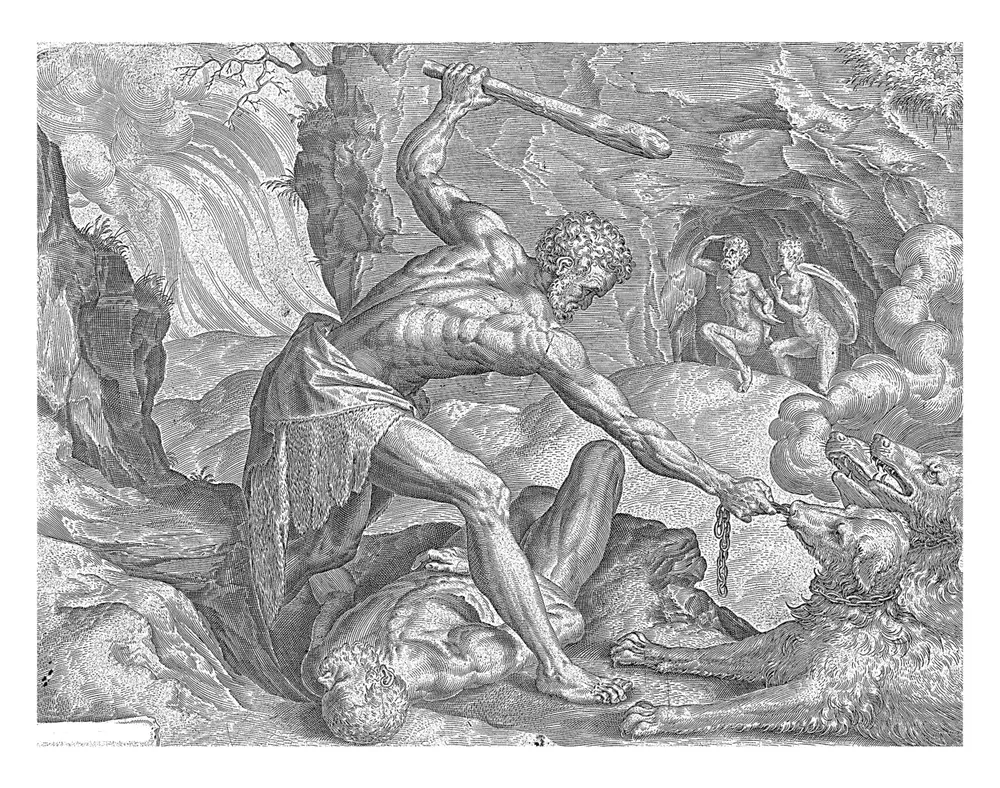
Hercules, the demigod son of Zeus, grew into a mighty warrior in the human world. He was well-respected and generally adored in his hometown of Thebes in Greece. Despite his lofty heritage, Hercules was a mortal. This background may not scream ‘ordinary world’, but it was business as usual for Hercules. You can also check out our guide on hero’s journey archetypes .
The Call to Adventure: Hercules Goes To War
Now for the next stage of the hero’s journey. Every year the people of Thebes were compelled to pay homage to the king of the Minyans, Erginus. Hercules isn’t happy about this state of affairs and, encountering some Minyans by chance, takes matters into his own hands, cutting off their noses, ears, and hands.
King Erginus is not impressed and subsequently declares war on Thebes – and Hercules in particular. The king’s army is no match for the demigod, though, and he dispatches it in short order. As a symbol of gratitude, the king of Thebes allows Hercules to marry his daughter, Megara.
Refusal of the Call: Hercules Goes Insane
Hercules happens to be Zeus’s illegitimate son, and this infuriates the jealous Hera, Zeus’s wife. She decides to drive him insane, and is so successful in her endeavors that Hercules goes seriously off the rails, even killing his three children.
For some, this represents the initial refusal stage of the hero’s journey as it represents Hercules’s refusal to take on the role of hero, becoming the dark reflection of the hero, instead. Even if he had a little help with this decision.
Meeting the Mentor: Hercules Visits the Oracle of Delphi
Hercules, recovering from the temporary insanity, is devasted at what he has done. He decides that a visit to the Oracle of Delphi is needed to help him figure out what to do. The Oracle was a high priestess, serving in the sanctuary of Apollo, with powerful prophetic abilities.
Here, the Oracle advises him that the best way to atone for his terrible actions is to serve King Eurystheus.
Crossing the First Threshold: Hercules Undertakes Ten Labors
King Eurystheus accepts Hercules’s service offer but tells him he’ll need to undertake ten labors successfully. And that’s not a typo; there were initially ten rather than twelve labors. Hercules agrees – he is the son of Zeus, after all, so he has a level of confidence that we mere mortals may struggle to muster when faced with ten near-impossible endeavors.
Tests and Meeting Allies and Enemies: Hercules Meets Athena and Chiron
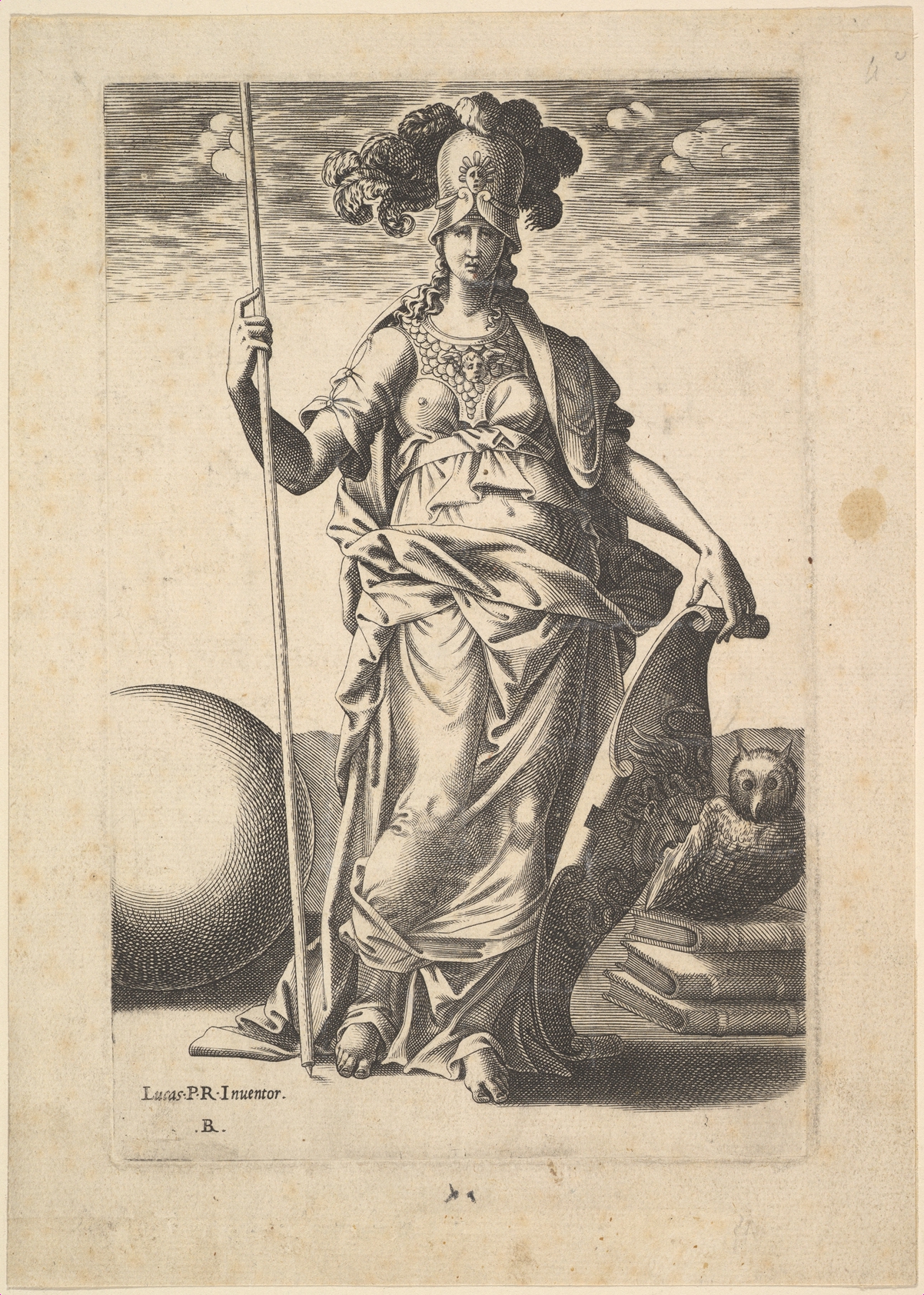
Hercules completes nine of the ten tasks. These missions include the Nemean Lion’s slaying, the Hydra’s vanquishing, capturing the Cretan Bull, and retrieving Hippolyte’s belt.
Some of the allies that Hercules meets on his adventures are Athena and the centaur Chiron, but it wasn’t all plain sailing, even with a ton of supernatural aid. The Greek god Poseidon’s sons and Sarpedon (another of Zeus’s offspring) were just a few of the characters that cause trouble for the erstwhile hero during his quest. But being Hercules, he vanquishes them all.
Approaching the Inmost Cave: Hercules Travels to The Edge of The World
For his tenth labor, Hercules has to travel to the very edge of the world, Erytheia, sailing across the Atlantic Ocean to do so. His mission is to retrieve the Red Cattle of Geryon. This part of the hero’s journey concerns the approach to the inmost cave.
According to Joseph Campbell, who wrote widely on this structure, this part of the journey represents a pause before a shift: the hero’s mindset may change. He or she may be approaching unchartered territory, either physically or spiritually, and must draw on new energy to continue.
The Ordeal: Hercules Recovers the Golden Apples of Hesperides
Those allies we mentioned above who gave Hercules a helping hand in his quest? King Eurystheus wasn’t best pleased with the intervention and stated that two of the ten labors that had been assigned were, therefore, invalid. The king subsequently set two additional tasks – bringing the total to twelve labors.
These extra missions were to bring back the golden apples of Hesperides and to fetch Cerberus from Hades. When Hercules successfully completes these two extra tasks, he becomes a bona fide Greek hero.
The Reward: Hercules Enters Olympus
It was never about treasure. By completing the twelve labors, Hercules is seen as atoning for the murder of his children and is now ready to join the godly world of his father in Olympus . But the hero’s journey doesn’t end there…
The Road Back: Hercules Returns to Earth
According to the Disney version of this Greek myth, Hercules isn’t satisfied with life in Olympus and returns to the ordinary world to live as a mortal with his beloved Meg (Megara). However, this isn’t exactly what happens, according to Greek mythology.
In the original legend, Hercules gives his wife to his friend Iolaus (okaaaay) and decides to live out his life as a heroic wanderer on Earth.
The Resurrection: Hercules is Reborn Immortal
Zeus granted Hercules immortality after successfully undertaking his twelve labors. According to some versions of the tale, this happened immediately after he returned from Hades with Cerberus in tow, and in others, it occurred at a later point. Either way, Hercules’s rebirth as an immortal is clearly the Resurrection stage of his journey.
As well as gaining God status and access to Mount Olympus, Hercules is now able to use the lessons he has learned throughout the hero’s journey to heal his past wounds and be a true hero. He is triumphant in every sense of the word, has atoned, and gained spiritual freedom.
Hero’s Journey Archetypes
When it comes to main characters, there are several archetypes. Hercules is generally considered an example of the Warrior archetype, as he primarily uses his physical skills and strength to overcome challenges and trials.
However, the character in Disney’s Hercules can be categorized differently. In Disney’s retelling of the tale, Hercules is cast in the Orphan role, cast adrift in the Ordinary World and needing to discover himself and his powers to gain fulfillment. The role of the hero does not sit quite comfortably at first; think Peter Parker in Spiderman , another Orphan archetype.
This shift of Hercules’s character from Warrior to Orphan archetype tells an interesting story about general cultural shifts that have occurred over time and the nature of our understanding of the ‘hero’ role and its mentality.
If you enjoyed this analysis, check out our guide to movies that follow the hero’s journey.

Melanie Smith is a freelance content and creative writer from Gloucestershire, UK, where she lives with her daughter, long-suffering partner, and cat, The Magical Mr. Bobo. Her blog posts and articles feature regularly in magazines and websites around the world.
View all posts
- History Classics
- Your Profile
- Find History on Facebook (Opens in a new window)
- Find History on Twitter (Opens in a new window)
- Find History on YouTube (Opens in a new window)
- Find History on Instagram (Opens in a new window)
- Find History on TikTok (Opens in a new window)
- This Day In History
- History Podcasts
- History Vault
By: History.com Editors
Updated: April 17, 2024 | Original: February 7, 2011

Hercules (known in Greek mythology as Heracles or Herakles) is one of the best-known heroes in ancient mythology. His life was not easy—he endured many trials and completed many daunting tasks—but the reward for his suffering was a promise that he would live forever among the gods at Mount Olympus.
Was Hercules a God?
Hercules was not a god but was born a mortal, although, like many mythic heroes, he had a complicated family tree. According to legend, his father was Zeus, ruler of all the Greek gods on Mount Olympus and all the mortals on earth, and his mother was Alcmene, the granddaughter of the hero Perseus. (Perseus, who was also said to be one of Zeus’ sons, famously beheaded the snake-haired Gorgon Medusa .)
Did you know? The constellation Hercules is the fifth-largest one in the sky.
Then, after Hercules was born, Hera sent two snakes to kill him in his crib. The infant Hercules was unusually strong and fearless, however, and he strangled the snakes before they could strangle him.
But Hera kept up her dirty tricks. When her stepson was a young adult, she cast a kind of spell on him that drove him temporarily insane and caused him to murder his beloved wife and their two children.
Guilty and heartbroken, Hercules tracked down Apollo, the god of truth and healing (and another of Zeus’ sons), and begged to be punished for what he had done.
The 12 Labors of Hercules
Apollo understood that Hercules’ crime had not been his fault—Hera’s vengeful actions were no secret—but still he insisted that the young man make amends. He ordered Hercules to perform 12 labors for the Mycenaen king Eurystheus. Once Hercules completed every one of the labors, Apollo declared, he would be absolved of his guilt and achieve immortality.
The Nemean Lion
First, Apollo sent Hercules to the hills of Nemea to kill a lion that was terrorizing the people of the region. (Some storytellers say that Zeus had fathered this magical beast as well.) Hercules trapped the lion in its cave and strangled it. For the rest of his life, he wore the animal’s pelt as a cloak.
The Lernaean Hydra
Second, Hercules traveled to the city of Lerna to slay the nine-headed Hydra—a poisonous, snake-like creature who lived underwater, guarding the entrance to the Underworld. For this task, Hercules had the help of his nephew Iolaus. He cut off each of the monster’s heads while Iolaus burned each wound with a torch. This way, the pair kept the heads from growing back.
The Golden Hind
Next, Hercules set off to capture the sacred pet of the goddess Diana: a red deer, or hind, with golden antlers and bronze hooves. Eurystheus had chosen this task for his rival because he believed that Diana would kill anyone she caught trying to steal her pet; however, once Hercules explained his situation to the goddess, she allowed him to go on his way without punishment
The Erymanthean Boar
Fourth, Hercules used a giant net to snare the terrifying, man-eating wild boar of Mount Erymanthus.
The Augean Stables
Hercules’ fifth task was supposed to be humiliating as well as impossible: cleaning all the manure out of King Augeas’ enormous stables in a single day. However, Hercules completed the job easily, flooding the barn by diverting two nearby rivers.
The Stymphlaian Birds
Hercules’ sixth task was straightforward: Travel to the town of Stymphalos and drive away the huge flock of carnivorous birds that had taken up residence in its trees. This time, it was the goddess Athena who came to the hero’s aid: She gave him a pair of magical bronze krotala, or noisemakers, forged by the god Hephaistos. Hercules used these tools to frighten the birds away.
The Cretan Bull
Next, Hercules went to Crete to capture a rampaging bull that had impregnated the wife of the island’s king. (She later gave birth to the Minotaur, a creature with a man’s body and a bull’s head.) Hercules drove the bull back to Eurystheus, who released it into the streets of Marathon.
The Horses of Diomedes
Hercules’ eighth challenge was to capture the four man-eating horses of the Thracian king Diomedes. He brought them to Eurystheus, who dedicated the horses to Hera and set them free.
Hippolyte’s Belt
The ninth labor was complicated: stealing an armored belt that belonged to the Amazon queen Hippolyte. At first, the queen welcomed Hercules and agreed to give him the belt without a fight. However, the troublemaking Hera disguised herself as an Amazon warrior and spread a rumor that Hercules intended to kidnap the queen. To protect their leader, the women attacked the hero’s fleet; then, fearing for his safety, Hercules killed Hippolyte and ripped the belt from her body.
The Cattle of Geryon
For his 10th labor, Hercules was dispatched nearly to Africa to steal the cattle of the three-headed, six-legged monster Geryon. Once again, Hera did all she could to prevent the hero from succeeding, but eventually, he returned to Mycenae with the cows.
The Apples of Hesperides
Next, Eurystheus sent Hercules to steal Hera’s wedding gift to Zeus: a set of golden apples guarded by a group of nymphs known as the Hesperides. This task was difficult—Hercules needed the help of the titans Prometheus and Atlas to pull it off—but the hero eventually managed to run away with the apples. After he showed them to the king, he returned them to the gods’ garden where they belonged.
For his final challenge, Hercules traveled to Hades to kidnap Cerberus, the vicious three-headed dog that guarded its gates. Hercules managed to capture Cerberus by using his superhuman strength to wrestle the monster to the ground. Afterward, the dog returned unharmed to his post at the entrance to the Underworld.
How Did Hercules Die?
After completing his 12 Labors, Hercules had a number of other adventures—rescuing the princess of Troy and battling for control of Mount Olympus—but none were as taxing, or as significant, as the labors had been.
Later in his life, Hercules married his second wife, Deianira. When a centaur (a half-man, half-horse) attempts to steal her away, Hercules shot him with an arrow that he had soaked in the poison of the Hydra. As he lay dying, the centaur, realizing that his own blood is now also poisonous, gave his blood-stained tunic to Deianira, lying to her that it will forever bind Hercules to her.
Years later, when Deianira hears a rumor that Hercules is having an affair, she gave him the blood-stained tunic to wear, hoping it will bring him back to her. However, the poisoned blood on the tunic burns Hercules’ flesh, causing intense pain. Realizing that he has been poisoned, Hercules builds his own funeral pyre and burns himself to death on it.
After he died, Athena carried him to Olympus on her chariot. According to legend, he will spend the rest of eternity with the gods.

HISTORY Vault: The Greek Gods
The Greek gods acted like a dysfunctional feuding family, often displaying near-human frailties. Visit magnificent monuments and temples to see how the gods' changing faces reflected the advancement of the Greeks.

Sign up for Inside History
Get HISTORY’s most fascinating stories delivered to your inbox three times a week.
By submitting your information, you agree to receive emails from HISTORY and A+E Networks. You can opt out at any time. You must be 16 years or older and a resident of the United States.
More details : Privacy Notice | Terms of Use | Contact Us

The Twelve Labors of Hercules: A Hero's Journey
Ever wondered about the ins and outs of Hercules' epic journey? Well, let's chat about it. We're going to break down his legendary Twelve Labors and see how they match up with the famous hero's journey concept – you know, the one outlined by scholar Joseph Campbell.
We're talking about the daring start, the tough challenges, and finally, the victorious return. We'll see how our hero Hercules, a real old-school hero, handles his unique transformation journey. And believe me, it's not a walk in the park – we're talking about battling monsters, dealing with tricks, and yes, even some meddling from the gods.
As we dig into this side-by-side analysis, you'll start to see the timeless wisdom tucked away in these old Greek myths. And who knows? You might even find yourself more intrigued by Hercules' extraordinary story.
Understanding Hercules' Ordinary World

Let's dive in and better understand Hercules' everyday life. You see, Hercules was highly respected in his hometown of Thebes. He led a privileged life, widely admired by all. Yet, his life wasn't all sunshine and roses, as he faced the immense challenge of confronting King Erginus, the Minyans' ruler. Here, Hercules' bravery truly shines as he steps up against the tyrant king, earning the Thebans' love even more.
Let's not forget, Hercules was married to Megara, Erginus' daughter, which only increased his standing in society. However, it wasn't all smooth sailing. His life was filled with turmoil, largely thanks to Hera's constant interference. Hercules, despite his heroic image, had his fair share of trials and tribulations. It goes to show, even heroes aren't exempt from life's struggles.
In his search for peace, Hercules turns to the Oracle of Delphi, leading him down a path of redemption. This point is a game-changer, signaling the start of his transformative journey. When we look at Hercules' everyday world, we see a mix of privilege and hardship. It's an enlightening lesson for us, as Hercules' Heroes, showing us that our struggles are part and parcel of our journeys, much like they were for Hercules.
The Call and Refusal: Hercules' Inner Battle
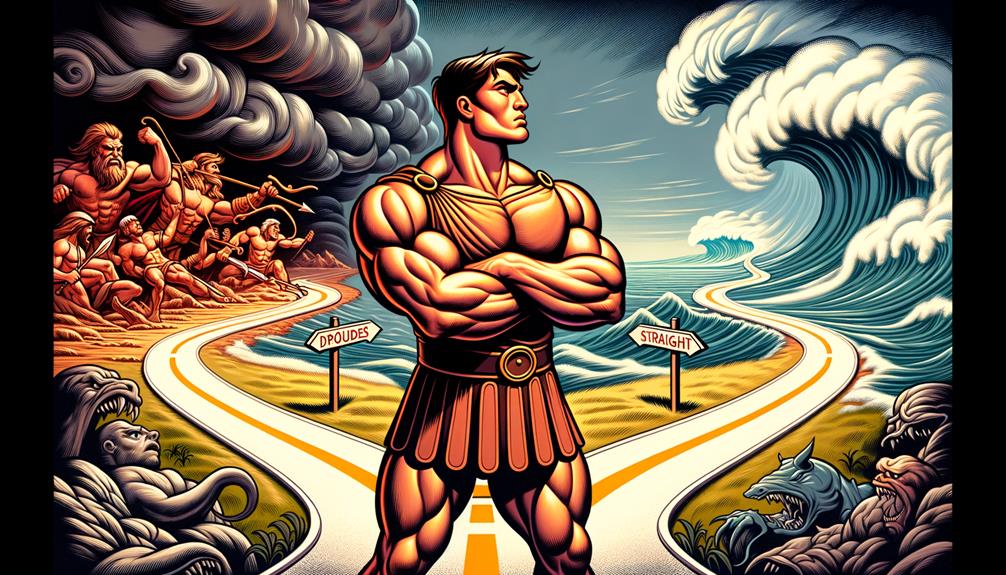
Imagine Hercules, our legendary hero, trying to navigate his regular, chaotic day-to-day life, when suddenly he's faced with a tough decision. He's tasked with completing the twelve labors – a monumental challenge that scares him to his core. This stage of his journey, known as 'The Call and Refusal', really shows us his human side, showcasing his fears and vulnerabilities.
Think about it like this – Hercules' internal struggle is something every hero goes through. The adventure calling out to them is daunting enough, but it's saying "no" that really puts their courage to the test. As for Hercules, the twelve labors are more than just tasks, they symbolize a chance to transcend his normal life. He's scared, so his first reaction is to deny the call. But in a weird twist, it's this rejection that nudges him to take that first step.
Hercules' Allies, Enemies, and Tests
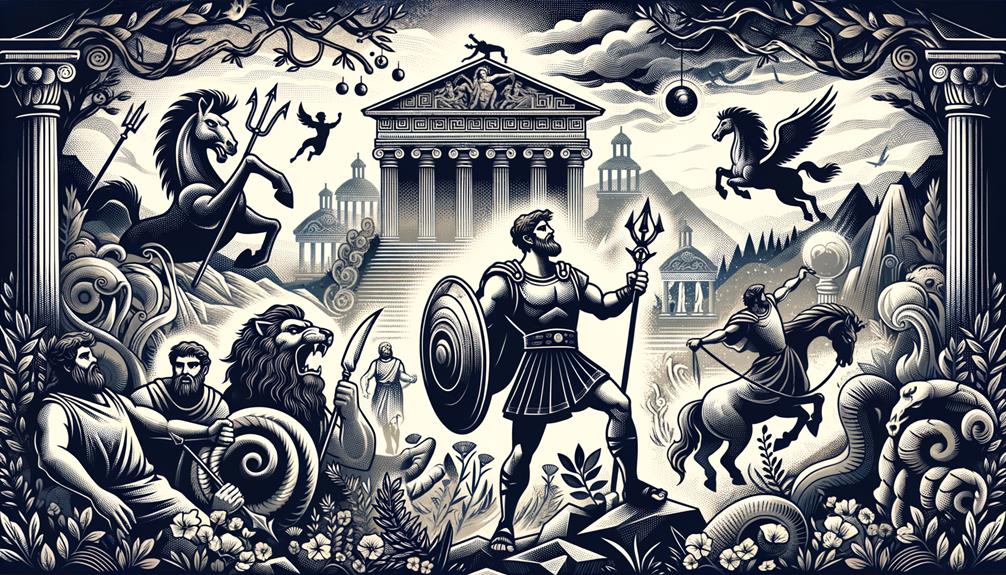
Hercules, the famed hero of ancient lore, sets out on an extraordinary adventure filled with allies and foes, each providing unique challenges that shape him into the hero he is destined to be. His friends, including divine entities like Athena and ordinary humans like Iolaus, offer him priceless advice, aid, and moral encouragement. They embody the positive traits of Hercules' persona: his bravery, determination, and ability to form lasting friendships.
On the other hand, Hercules also has to confront formidable foes, such as the spiteful Hera and the terrifying Nemean lion. These foes symbolize the darker sides of his personality, like his unmanageable anger and impulsive behavior. They act as trials forcing Hercules to confront and conquer his inner weaknesses.
The trials Hercules goes through are more than just physical confrontations. They're also mental and moral dilemmas. He must tackle tasks that require more than just raw power. They demand wisdom, resilience, and a rock-solid moral compass. These trials serve to shape him into a more well-rounded individual, propelling him along his heroic journey. Through Hercules' friends, foes, and trials, we see his transition from a volatile hero into a paragon of power and virtue.
The Ordeal and Reward: Hercules' Transformation
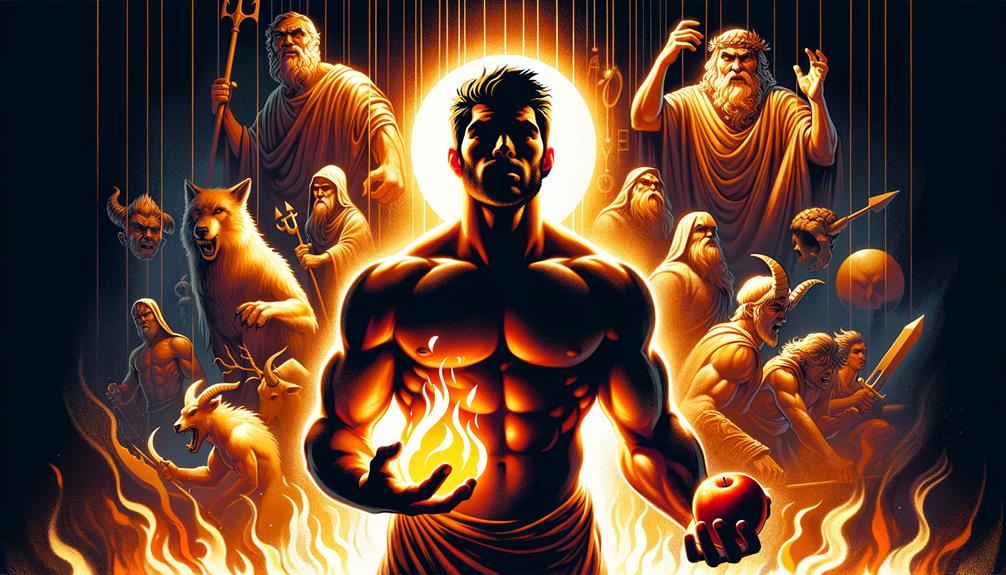
Let's dive deep into the life-changing journey of Hercules, where he faced ordeals that pushed him to his limits and rewards that reshaped his entire existence. The hero's journey is often a rollercoaster ride, and Hercules' was no exception. His mission? To make up for his past by completing twelve challenging tasks.
- He had to get his hands on the golden apples of the Hesperides. This wasn't a simple task – it demanded both physical strength and sharp wit.
- Capturing Cerberus from Hades was also on his list, which meant a risky trip into the underworld itself.
- These trials were part of Hercules' attempt to make amends for the devastating mistake of killing his own children.
- His transformation and rebirth into an immortal symbolize a deep, spiritual healing.
- At last, Hercules ascended to Mount Olympus, marking his growth into a true hero and gaining spiritual liberation.
These tasks are a testament to Hercules' transformation. He evolved from a tormented soul, burdened by his past, to a heroic figure akin to a god, emphasizing the transformative power of such a journey. His tale teaches us a valuable lesson – it's not just the destination that matters, but the journey and the change that comes with it.
Hercules' Resurrection and Return
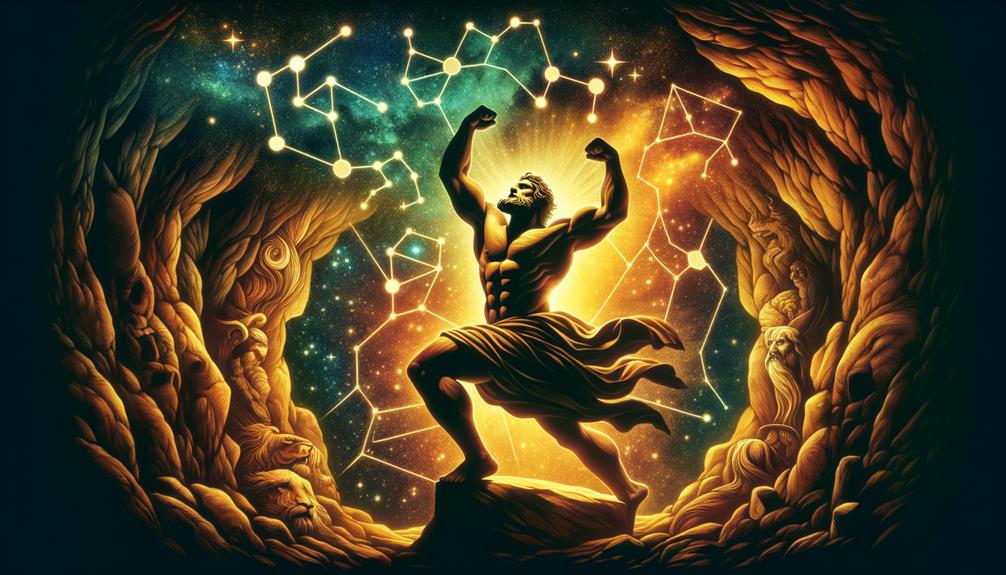
So, let's talk about the last chapter in Hercules' incredible tale. What we observe here is Hercules' transformation from mortal to divine, a powerful symbol of his heroic journey's completion and the ultimate proof of his redemption and rebirth. After finishing his twelve labors, Hercules makes amends for his past mistakes and gains the ability to live forever, essentially getting a second chance at life as an eternal hero.
This rebirth and return are meaningful in so many ways. They mark his spiritual liberation, his healing, and the wrap-up of his heroic journey. This journey changes him in many ways, not just physically but also spiritually. When Zeus gives him the gift of immortality, it's like a fresh start and a massive change in his journey.
Now, here's a cool twist in the story when we look at the Disney version versus the original Greek mythology . In Disney's take, Hercules decides to go back to his normal, mortal life with Megara. But in the original Greek story, instead of settling down, he chooses to keep wandering the Earth like a hero, which presents an interesting contradiction. He's a hero, but he's also forever tied to his human origins. This conflict reminds us of how complex the hero's journey can be, full of challenges, victories, and ultimately, a rise to a higher level.
Frequently Asked Questions How Is Hercules a Hero's Journey?
So, you're curious about Hercules and his legendary journey? It's a fascinating story that truly embodies the essence of a hero's quest. Here's the scoop: Hercules begins his tale as a well-regarded citizen of Thebes. But then, he's faced with a series of daunting challenges, the most memorable of which are his notorious twelve labors. After overcoming these hardships, his story reaches an inspiring conclusion – Hercules attains not just salvation, but also ascends to a divine stature. It's a quintessential tale of a rise from humble beginnings to the heights of Olympus.
What Are the 12 Steps in a Hero's Journey?
Let's chat about the 12 steps that typically define a hero's journey. It all starts in an ordinary world, where our hero lives a normal life. Suddenly, an adventure beckons, but initially, the hero is hesitant to accept the challenge. That's when a mentor steps in, offering guidance and support. With newfound courage, the hero crosses the threshold into a world of trials and challenges.
These tests prepare the hero for the impending ordeal, a major conflict that pushes them to their limits. After overcoming this difficult situation, the hero receives a reward. However, they must then embark on the road back home, often facing additional trials.
In a moment of resurrection, the hero experiences a significant transformation, leading to the final step – returning home, but now with a newfound wisdom or power, often symbolized by an elixir. This narrative arc is prevalent in many of the stories we love and relate to. It's a timeless formula that continues to resonate with audiences across the globe.
What Is the Point of the 12 Labors of Hercules?
You know, when I think about Hercules and his famous 12 labors, it strikes me as a classic story of bouncing back and personal development. It's like a journey, right? Each task he tackles is a hurdle he has to overcome, showing his inner strength and grit. And in the end, it's all about the victory of goodness over the wrong. Pretty cool, huh?
What Are the 12 Steps to Being a Hero?
From my perspective, if you want to step into the shoes of a hero, there's a 12-step process you need to go through. Start by setting out on an exhilarating journey. You're bound to come across obstacles along the way. Tackle them head-on, learn from them, and use that knowledge to your advantage. The aim is to come back from your expedition a stronger person. It's all about embracing change and growing as an individual.
Heracles (Hercules): The Twelve Labors Hero's Journey
The Hero's Journey is a framework that scholar Joseph Campbell came up with that many myths and stories follow. Many storytellers and story-readers find it a useful way to look at tale. (That's actually putting it lightly. Some people are straight-up obsessed .) Chris Vogler adapted Campbell's 17 stages of a hero's journey, which many screenwriters use while making movies. Vogler condensed Campbell's 17 stages down to 12, which is what we're using. To read a general explanation of the 12 stages, click here .
The story of Heracles' Twelve Labors fits almost perfectly into this structure. Here's how we've diced up the story:
Stage 1: Ordinary World
We begin in Heracles' hometown of Thebes. He's a total stud, a global hero, and the most popular mortal known to man.
Stage 2: Call to Adventure
For some reason, Heracles' hometown of Thebes has to pay homage every year to Erginus, the king of the Minyans. This really frosts Heracles' cookie. One day, he comes across some Minyans in the road, and he cuts off their ears, noses, and hands. Hearing of this, the King of the Minyans is enraged and declares war on Heracles and the people of Thebes. Heracles obliterates them. The King of Thebes is so happy that he lets Heracles marry his daughter, Megara. Everything is coming up roses for Heracles, the man of the hour.
Stage 3: Refusal
Zeus' wife, Hera, hates Heracles with the passion of a thousand fires. She wants to ruin his life, because he is Zeus' illegitimate son (who he had with Alcmene). Hera decides to drive Heracles to insanity. This causes Heracles to behave in some seriously un-hero-like ways. He kills his own children. You could argue that he kind of refuses his role of "hero" by behaving in such a heinous way.
Stage 4: Meeting with the Mentor
Heracles goes to the Oracle of Delphi. The Oracle tells him he can atone or make up for his horrible crimes by serving King Eurystheus of Argos.
Stage 5: Crossing the Threshold
Heracles offers to serve King Eurystheus of Argos in order to atone for the crimes he has committed. King Eurystheus tells him he must successfully complete ten labors. Heracles agrees.
Stage 6: Tests, Allies, Enemies
Heracles tackles the ten labors perfectly. He does so with the help of certain gods and allies, and he encounters several enemies and foes along the way.
Stage 7: Approach to Inmost Cave
For his tenth and last labor, Heracles must go to Erytheia, literally the edge of the world. He must sail across the Atlantic Ocean to do this. The Greeks believed that there really was an edge of the world, and Heracles was totally not scared to travel there.
Stage 8: Ordeal
King Eurystheus tells Heracles that two of the labors weren't completed in a satisfactory way, because Heracles had help with them. So, King Eurystheus commands Heracles to complete two additional labors. Heracles says, "bring it." After successfully capturing the Golden Apples of Hesperides, Heracles' final task is the most difficult and terrifying one. He must venture to the underworld and bring Cerberus, the vicious three-headed guard dog, to the surface for King Eurystheus to see. Basically, Heracles has to go to the land of the dead and return alive. Oh, and he must bring a little souvenir back with him. He successfully does this, and this time, he really and truly proves himself a hero.
Stage 9: Reward (Seizing the Sword)
After completing these twelve labors, Heracles is finally able to atone for the murder of his children. His guilty conscience is wiped clean.
Stage 10: The Road Back
Heracles gives his wife to his friend/nephew Iolaus and goes on his merry way. Whaaa?
Stage 11: Resurrection
Some say that Heracles is made immortal after completing these twelve labors. Others say he is granted immortality a little later on.
Stage 12: Return with Elixir
Regardless of when he was made immortal, one thing is certain: Heracles eventually becomes a real god.
Tired of ads?
Cite this source, logging out…, logging out....
You've been inactive for a while, logging you out in a few seconds...
W hy's T his F unny?

Hercules Son of Zeus: The Legendary Hero of Ancient Greek Mythology
In the vast realm of Greek mythology, one figure stands out as the epitome of strength, courage, and heroism: Hercules son of Zeus. Known for his incredible feats and legendary adventures, Hercules has become a symbol of heroism and endurance, captivated generations with his larger-than-life persona.
This article delves into the origins of Hercules, explores each phase of his remarkable life, explore some of the most thrilling tales from his legendary adventures and ultimately highlights the enduring legacy of this iconic hero.


Table of Contents
Origins of hercules son of zeus.
Hercules, also known by his Greek name Heracles , was born to Alcmene, a mortal woman, and Zeus , the king of gods. Zeus visited Alcmene in the guise of her husband Amphitryon, resulting in the conception of Hercules. This divine heritage bestowed upon him immense strength and resilience, making him a demigod – a half-god, half-human being and a destiny to become a hero.
Childhood and Training
From an early age, it was clear that Hercules possessed superhuman strength and abilities. However, his path to heroism was not without challenges. As an infant, baby hercules strangled two snakes sent to kill him in his cradle by Hera, Zeus’ wife, in an attempt to eliminate him. This act showcased his tremendous power even in his early years.
To prepare Hercules for his future endeavors, he was sent to train under various mentors, including the centaur Chiron. Under Chiron’s guidance, Hercules honed his physical strength, combat skills, and intellect. The training proved instrumental in shaping him into the true hero he would become.
The 12 Labors of Hercules
Hercules’ life can be divided into distinct phases, with each phase marked by extraordinary challenges and accomplishments. The most renowned episode of Hercules’ journey is his completion of the Twelve Labors.
Driven to madness by Hera, Zeus’ wife and Hercules’ stepmother, he unwittingly killed his wife and children. In remorse, Hercules sought redemption through twelve seemingly insurmountable tasks assigned by King Eurystheus. The Twelve Labors became a testament to Hercules’ indomitable spirit and unwavering determination.
- Slaying the Nemean Lion : The first labor required Hercules to defeat a ferocious lion with impenetrable skin could not be pierced by mortal weapons. Using his immense strength, Hercules strangled the lion and later donned its impenetrable hide as armor.
- Slaying the Hydra : Hercules faced a monstrous serpent with multiple heads that grew back when severed. With the aid of his nephew Iolaus, Hercules managed to defeat the Hydra by cauterizing its neck stumps to prevent regeneration.
- Capturing the Golden Hind : Hercules embarked on a hunt to capture a sacred deer with golden antlers. Despite its incredible speed and agility, guided by the goddess Artemis, he successfully trap and caugh the elusive creature.
- Capturing the Erymanthian Boar : Hercules subdued a fearsome and wild boar of mount erymanthus that terrorized the region of Erymanthia. Using his wits and strength capturing it alive and bringing it back to Eurystheus.
- Cleaning the Augean Stables : As part of a seemingly impossible task, Hercules was assigned to clean the filth-ridden stables of King Augeas which housed an enormous number of cattle in a single day. He accomplished this by diverting two rivers to flush the stables clean.
- Defeating the Stymphalian Birds : Hercules confronted a carnivorous birds with bronze beaks and metallic feathers that terrorized the region of Stymphalia. Using a rattle provided by Athena, he scared the birds into flight and shot them down with arrows.
- Capturing the Cretan Bull : The labor involved subduing a powerful bull wreaking havoc on Crete. Hercules successfully wrestled it into submission before bringing it back to King Eurystheus who later released it.
- Obtaining the Mares of Diomedes : Hercules was tasked with stealing the man-eating horses of Diomedes, the Thracian king. He overpowered Diomedes and fed him to his own horses before taming them.
- Obtaining the Belt of Hippolyta : Hercules set out to obtain the magical belt of Hippolyta, queen of the Amazons. Despite facing numerous challenges, he succeeded in securing the prized artifact.
- Obtaining the Cattle of the Monster Geryon : Hercules traversed great distances to steal the cattle of Geryon, a fearsome triple-bodied monster. With his exceptional archery skills, he defeated Geryon and drove the cattle back to Eurystheus.
- Stealing the Apples of the Hesperides : Hercules undertook a perilous journey in a distant garden at the edge of the world to retrieve the golden apples of the Hesperides, which were guarded by a dragon. With the help of Atlas, he completed this labor and returned the apples to Eurystheus.
- Capturing Cerberus, the Guardian of the Underworld : The final labor required Hercules to venture into the depths of the Underworld and capture Cerberus, the three-headed dog guarding its gates. Through his sheer strength, he successfully accomplished this daunting task, bringing Cerberus to King Eurystheus.
Other Heroic Exploits
Beyond his Twelve Labors, Hercules son of Zeus embarked on numerous other heroic exploits that showcased his valor and strength.
- Rescue of Hesione : Hercules freed Hesione from a sea monster by sacrificing himself and allowing Zeus to rescue him with lightning bolts.
- Battle against Giants : He played a pivotal role in the Gigantomachy, a war between gods and giants. His strength proved instrumental in defeating these formidable adversaries.
- Rescue of Prometheus : Hercules freed Prometheus from eternal torment by slaying the eagle sent by Zeus to peck at his liver.
The tale of Hercules son of Zeus continues to inspire and captivate audiences across generations. From his divine origins to his astounding feats of heroism. Hercules’ epic journey through the Twelve Labors showcased his immense strength, bravery, and determination. These trials not only cleansed him of his past sins but also solidified his status as the greatest hero in Greek mythology. Hercules’ story serving as a timeless reminder that even in the face of seemingly insurmountable challenges, true heroism can prevail.
Story of Odysseus: The Brilliant Hero of Greek Mythology
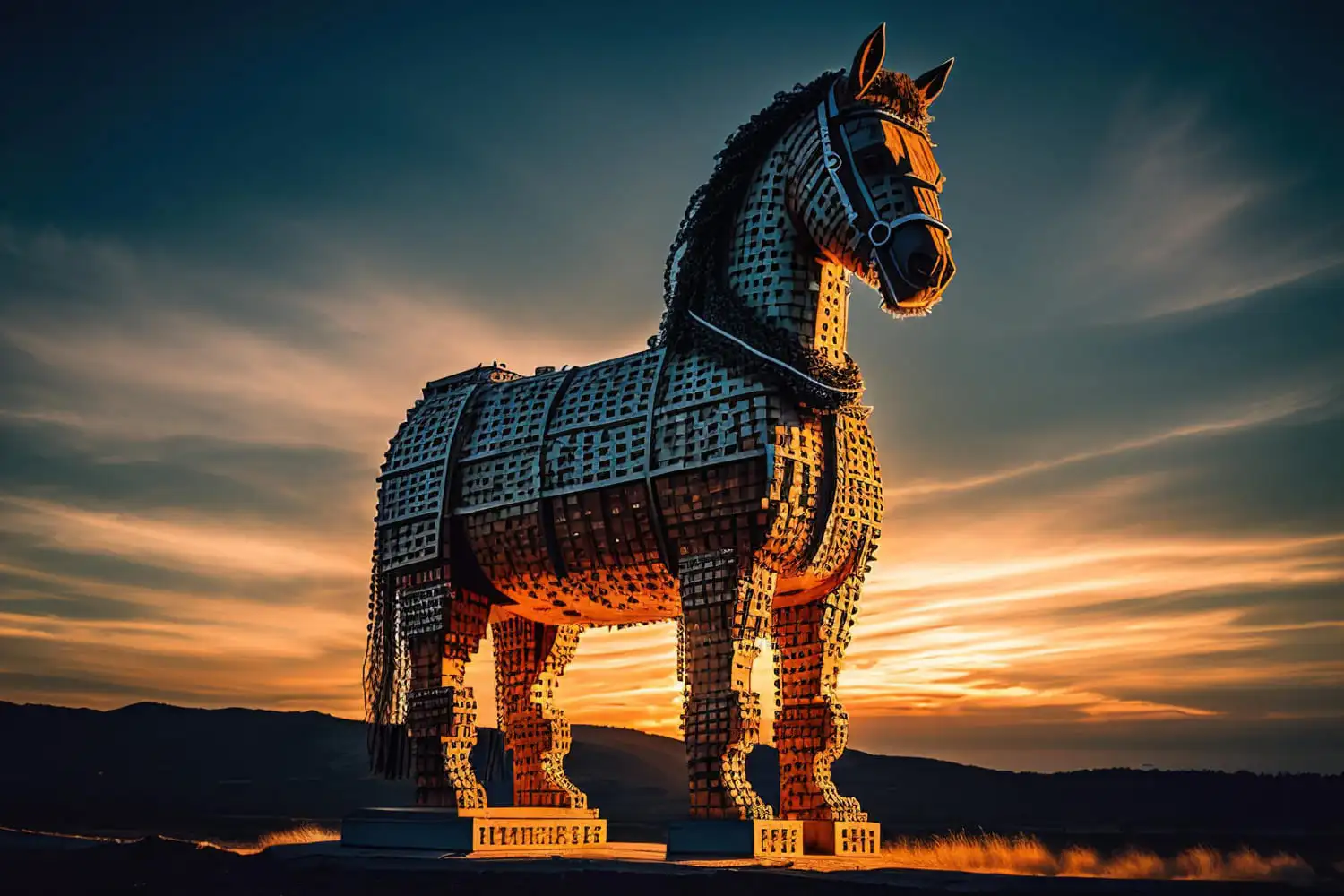
The Trojan War: The Epic Conflict in the Ancient City of Troy
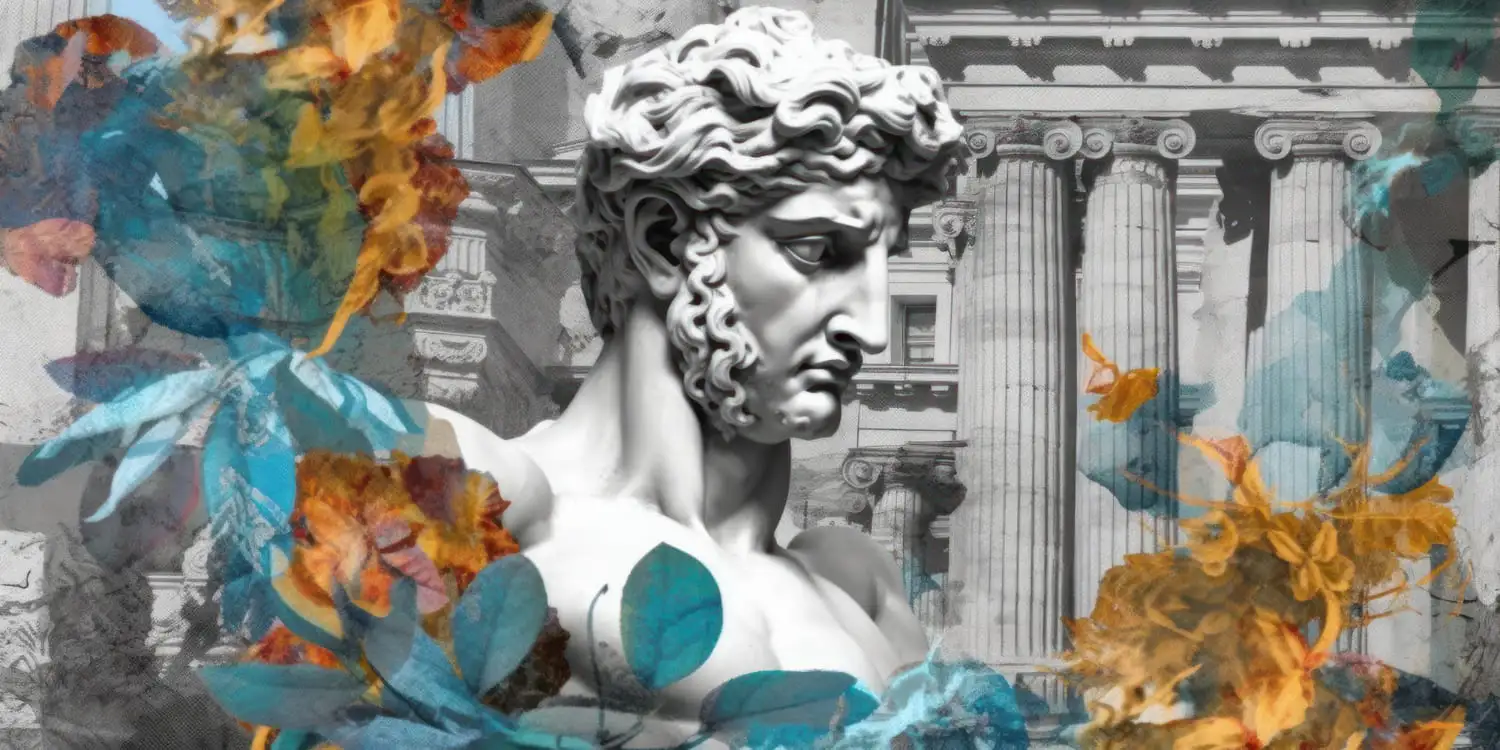
Greek Mythology: Exploring the captivating Ancient Tales and Their Modern Influence
Story of Medusa: a Tragic Snake-Haired Gorgon from Greek Mythology

[email protected]
081 8054 22671
Privacy Policy
Documentation
Wild Spirit
Finding your inner self.

Posted under
Zero to Hero: Hercules and his Hero’s Journey
As stated in my last blog, this week I will be showing an example of the Hero’s Journey or Joseph Campbell’s monomyth in a classic tale: Hercules. Recall that the hero’s journey is an archetype or pattern of that acts as a blueprint to tell a specific type of story. It is broken down into three main steps: the departure, the initiation, and the return. Now, unless you have taken greek mythology (or read Percy Jackson), you probably do not know the real story of Hercules and his 10/12 trials. What you do know is the Disney animated Hercules — the hero gets the girl and its a classic love story in the end. Since Campbell’s monomyth is applicable in some way to every hero story and for the sake of universal recognition, we will be looking at Disney’s Hercules to chart our tale. Secretly I just wanted a reason to watch Hercules again.
The Departure
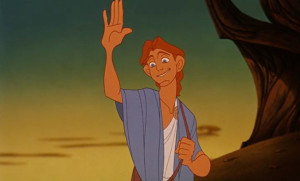
Hercules leaves home because he is called to find his true self. Previously he had made a mess of things for his “father” in the marketplace because he was too strong to play frisbee with the other kids. Realizing that he might not belong he asks his parents “why.” Hercules finds out that he is adopted and looks to his only clue — the necklace of Zeus’ lightening bolt– to the past. Hercules sets out on the quest to find his identity and fulfills the monomyth’s departure sequence.
The Initiation
In this phase of the hero’s journey change occurs to the hero; in other words they become the hero — physically and mentally. The individual faces challenges and trials to build themselves anew and create the hero image.
Hercules meets Phil who at first denies Hercules training. However, since Hercules found out his dad was Zeus, Phil decides to give him a shot. In the beginning of the trials, Hercules was scrawny and didn’t have the hero physique that comes with super strength.
Before the initiation . . .

After the initiation . . .
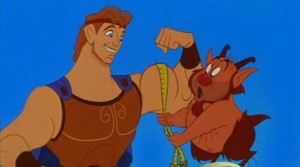
Hercules becomes the hero he always knew he could be. He still has his kind heart and the makings of a hero on the inside too. The completion of this face signifies that the hero is ready to rejoin the world and conquer the task.
Normally the return comes from a quest accomplished to be reborn. In this case, Hercules is reborn as a god in his return from the underworld. He conquers death and is reborn to return a new person.
Also in the return Hercules is allowed to journey home. The journey home is a crucial point of the hero’s journey because it signifies full transformation.

In the end, the hero does not find home satisfying and ends up a wanderer; however, in Disney’s rendition Hercules leaves his home to live a mortal life with meg.
Realizing the Hero’s journey in stories and films is important to recognizing the journeys in our own lives that shape ourselves. Hercules teaches us all different lessons about ourselves. That is the idea of self-actualization through stories with moral lessons.
One thought on “ Zero to Hero: Hercules and his Hero’s Journey ”
I remember learning about mythology and heroes in 8th grade and I loved it! As you mentioned at the end I frequently think about “modern heroes” and applying these qualities to people I know.
Leave a Reply
You must be logged in to post a comment.

The Hero’s Journey: Exploring the Mythology of Hercules
Hercules: An Epic Tale of Heroism and Adventure
In the realm of Greek mythology, the name Hercules resonates with strength, courage, and legendary feats. This iconic hero has captured the imagination of countless generations, and his story continues to inspire and captivate audiences to this day. From ancient myths to modern adaptations, the theme of Hercules has stood the test of time, weaving a tale of heroism, adventure, and the triumph of the human spirit.
The tale of Hercules begins with his birth, born as the son of Zeus, the king of the gods, and Alcmene, a mortal woman. Endowed with incredible physical strength and god-like abilities, Hercules was destined for greatness. However, his journey was not an easy one, as he faced numerous trials and challenges that tested his character and resolve.
One of the most famous stories associated with Hercules is his Twelve Labors. These were a series of tasks assigned to him by King Eurystheus as a form of punishment for a crime committed in his youth. From slaying the fearsome Nemean Lion to capturing the Golden Hind of Artemis, Hercules demonstrated his immense strength and courage in overcoming these seemingly impossible tasks.
But Hercules’ journey was not just about physical prowess. It was also a tale of personal growth and redemption. In his quest for atonement, Hercules faced inner demons and struggled with his own mortality. Through his trials, he learned important lessons about humility, selflessness, and the power of love.
The theme of Hercules has been explored in various forms of media, including literature, art, and film. One notable adaptation is Disney’s animated film “Hercules,” which brought the legendary hero to a new generation of audiences. The film beautifully captures the essence of Hercules’ journey, showcasing his transformation from an awkward outsider to a true hero.
The music in “Hercules” is particularly noteworthy, with songs like “Go the Distance” and “Zero to Hero” becoming instant classics. These songs evoke a sense of determination, resilience, and the belief that anyone can overcome their obstacles and achieve greatness.
Beyond its entertainment value, the theme of Hercules also holds valuable life lessons. It teaches us the importance of perseverance in the face of adversity, the power of self-belief, and the significance of using our strengths for the greater good. Hercules reminds us that heroes can come from unlikely places, and that true heroism lies not just in physical strength but in acts of kindness, compassion, and self-sacrifice.
The theme of Hercules is a timeless tale of heroism and adventure that continues to resonate with audiences of all ages. From his mythological origins to modern adaptations, Hercules’ story has inspired countless individuals to embrace their inner strength and face their own challenges head-on. Whether through literature, art, or film, the theme of Hercules reminds us that we all have the potential to be heroes in our own lives. So, let us embark on our own heroic journeys, facing our trials with courage, and discovering the power that lies within us.
What Is The Theme Song For The Movie Hercules?
The theme song for the movie Hercules is “Go the Distance”. It is performed by Roger Bart and has a length of 3 minutes and 14 seconds. The song is included in the soundtrack of the film and was composed by Alan Menken. “Go the Distance” is a powerful and uplifting song that captures the central theme of the movie, which is about finding one’s place in the world and overcoming obstacles to achieve greatness. The lyrics convey a sense of determination, perseverance, and the desire to go beyond one’s limits to achieve one’s dreams. The song has become a popular anthem and is often associated with the movie Hercules.
What Is The Cartoon Hercules From The 60s?
The cartoon Hercules from the 60s is an animated television series that aired from 1963 to 1966. It is loosely based on the character of Heracles, also known as Hercules, from Greek mythology. The show was part of the sword-and-sandal genre of films that were popular during that time.
Here are some key points about the cartoon Hercules from the 60s:
1. Inspiration: The cartoon series drew inspiration from the Greek mythological character Heracles, who is more commonly known by his Roman name Hercules. However, the show took creative liberties and was not a direct adaptation of the mythological stories.
2. Duration: The series ran for three years, from 1963 to 1966. It aired during a period when sword-and-sandal films, which depicted heroes and mythical elements, were popular.
3. Animation: Being an animated television series, the show featured vibrant and colorful visuals. It utilized traditional animation techniques prevalent during that era.
4. Plot: The cartoon Hercules followed the adventures of the titular character as he embarked on various quests and battles against mythological creatures and villains. The storyline often deviated from the original mythological tales to create exciting and entertaining episodes.
5. Influence: The show was part of a larger trend of Hercules-themed entertainment during the 1960s. The popularity of the character was fueled by the success of sword-and-sandal films like “Hercules” (1958) and “Hercules Unchained” (1959), which starred Steve Reeves.
6. Cultural Impact: The cartoon Hercules helped popularize the character among younger audiences and contributed to the lasting legacy of Hercules in popular culture. The series introduced the mythological hero to a new generation of viewers.
The cartoon Hercules from the 60s was an animated television series that loosely adapted the Greek mythological character Heracles, known as Hercules. It aired from 1963 to 1966, coinciding with the popularity of sword-and-sandal films. The show had a significant cultural impact and played a role in shaping the enduring image of Hercules in popular culture.
Who Is Hercules Sidekick?
Hercules, the renowned Greek demigod, is accompanied on his numerous heroic quests by his loyal and trusted sidekick, Iolaus. As a best friend and constant companion, Iolaus plays a vital role in aiding Hercules in his endeavors. Together, they journey across ancient lands, facing mythical creatures and overcoming various challenges.
Iolaus is depicted as a skilled warrior and a cunning strategist, complementing Hercules’ immense strength and power with his own set of abilities. While Hercules possesses god-like strength due to his divine heritage as the son of Zeus, Iolaus compensates for his lack of supernatural abilities with his quick thinking and resourcefulness.
Throughout their adventures, Iolaus proves to be an invaluable ally to Hercules. He offers moral support, providing encouragement and guidance when Hercules faces personal and emotional struggles. Iolaus is not just a sidekick but also a trusted confidant, someone Hercules can rely on in times of need.
In their quest to help people and rid the world of mythical monsters, Hercules and Iolaus form a formidable team. Their bond is strengthened by their shared experiences and the challenges they face together. Together, they tackle various threats, such as the Nemean Lion, the Lernaean Hydra, and the Erymanthian Boar, using their combined skills and abilities to ensure the safety of the innocent and the preservation of peace.
Hercules’ sidekick is none other than Iolaus, his loyal and trusted companion. Together, they embark on epic adventures, utilizing Hercules’ god-like strength and Iolaus’ quick thinking to overcome challenges and vanquish mythical foes. Their partnership showcases the power of friendship and demonstrates the importance of teamwork in achieving heroic feats.
The theme of Hercules is a timeless and captivating one that has captured the hearts of audiences for generations. The story of Hercules, a half-god with immense strength, embarking on epic adventures to help others and defeat mythical monsters, has resonated with people throughout history.
The animated television series, The Mighty Hercules, brought this legendary character to life in a way that captured the imagination of viewers. From 1963 to 1966, audiences were enthralled by the heroic exploits of Hercules and his loyal friend Iolaus. The show capitalized on the popularity of the sword-and-sandal genre of films during that time, creating a memorable and entertaining experience for viewers.
One of the standout elements of Hercules is its powerful and uplifting soundtrack. The song “Go the Distance” by Roger Bart perfectly encapsulates the determination and courage of the title character as he strives to overcome challenges and prove himself. This iconic song has resonated with audiences of all ages and has become a symbol of inspiration and perseverance.
Furthermore, the theme of Hercules, which centers around the idea of a hero’s journey, has transcended time and culture. The story of a hero facing trials and tribulations, finding strength within themselves, and ultimately triumphing over adversity is a universal tale that continues to resonate with people today. The character of Hercules serves as a symbol of hope, resilience, and the power of the human spirit.
The theme of Hercules is a powerful and enduring one that has captivated audiences for decades. Through its compelling storytelling, memorable characters, and uplifting soundtrack, Hercules has become a beloved and timeless tale of heroism. Whether in animated form or through other adaptations, the story of Hercules continues to inspire and entertain audiences, reminding us of the strength and potential within ourselves to overcome any obstacle and achieve greatness.
Doug Barlow
The Hero's Journey: Crossing the Threshold
Moviepix / Getty Images
- Tips For Adult Students
- Getting Your Ged
:max_bytes(150000):strip_icc():format(webp)/Deb-Nov2015-5895870e3df78caebc88766f.jpg)
- B.A., English, St. Olaf College
The hero , armed with the mentor’s gifts , agrees to face the journey. This is the turning point between Act One and Act Two, the crossing from the ordinary world into the special world. The hero is wholeheartedly committed and there is no turning back.
According to Christopher Vogler's The Writer's Journey: Mythic Structure , crossing the first threshold is often the result of some external force that changes the course or intensity of the story: someone is kidnapped or murdered, a storm hits, the hero is out of options or pushed over the brink.
Internal events might also signal the crossing of a threshold: the hero’s very soul is at stake and he makes a decision to risk everything to change his life, Vogler writes.
The Threshold
Heroes are likely to encounter threshold guardians at this point. The hero’s task is to figure out some way around these guardians. Some guardians are illusions and the energy of others must be incorporated by the hero, who realizes that the obstacle actually contains the means of climbing over the threshold. Some guardians simply need to be acknowledged, according to Vogler.
Many writers illustrate this crossing with physical elements such as doors, gates, bridges, canyons, oceans, or rivers. You may notice a clear shift in energy at this point.
A tornado sends Dorothy to the special world. Glinda, a mentor, begins teaching Dorothy the rules of this new place, gives her the magical ruby slippers, and a quest, sending her over a threshold where she will make friends, confront enemies, and be tested.
Tests, Allies, Enemies
The two worlds have a different feel, a different rhythm, different priorities and values, different rules. The most important function of this stage in the story is the testing of the hero to prepare her for the ordeals that lie ahead, according to Vogler.
One test is how quickly she adjusts to the new rules.
The special world is usually dominated by a villain or shadow who has set traps for intruders. The hero forms a team or a relationship with a sidekick. She also discovers enemies and rivals.
This is a "getting to know you" phase. The reader learns about the characters involved, the hero accumulates power, learns the ropes, and prepares for the next phase.
- The Role of Archetypes in Literature
- The Ordinary World in the Hero's Journey
- The Reward and the Road Back
- The Approach to the Inmost Cave in the Hero's Journey
- The Resurrection and Return With the Elixir
- The Hero's Journey: Meeting with the Mentor
- An Introduction to The Hero's Journey
- The Ordeal in the Hero's Journey
- The Hero's Journey: Refusing The Call to Adventure
- Russian Folklore: Baba Yaga as a Symbol of Mother Nature
- "The Wonderful Wizard of Oz" Study Guide
- The Heroes of Ancient Greece and Rome
- The Argonauts
- Ulysses (Odysseus)
- How Did the Greek Hero Hercules Die?
- Meaning Behind the Phrase to Cross the Rubicon

- Libraries Home
- Research Guides
Classical Mythology - Greek
- The Hero's Journey
- Reference Resources
Electronic Resources
The monomyth, or Hero’s Journey, was first recognized as a pattern in mythology by Joseph Campbell, who noticed that heroes in mythology typically go through the same 17 stages in their journey toward hero-dom.
The Hero’s Journey follows a path which is represented by a circle in which the hero travels into the unknown and is faced with many trials only to come full circle, returning to the known world. The path includes but is not limited to the following segments:
- Call to Adventure
- Supernatural Aid
- Cross the Threshold into the Unknown
- Mentors / Helpers
- Transformation
- Return from the Unknown
- Return to a Normal Life
A popular interpretation of the Hero’s Journey is Luke Skywalker’s journey toward Jedi Knighthood in the original Star Wars films. George Lucas found tremendous inspiration in the monomyth when creating the original trilogy. Fans will notice how closely the films mirror the monomyth pattern. Luke’s call to the rebellion, his aid of the force, the assortment of guides and companions, the many trials he faces along the way, his confrontation with Vader, the temptations of power, the destruction of the Empire, and the freedom of the galaxy from the Emperor’s evil tyranny. Several documentaries and books have been published on Campbell’s influence on the Star Wars films.
Model of the Monomyth
The Monomyth, or Hero's Journey, is a path commonly represented by a circle. Along this path the hero encounters numerous stages which he must overcome in order to progress.
Library Print & Media
- The Mythology of Star Wars An interview with George Lucas about the influence of his mentor, Joseph Campbell and his explanation of the Hero’s Journey. Available through Films on Demand.
- Wikipedia - Monomyth
- << Previous: Electronic Resources
- Last Updated: Jan 8, 2024 12:31 PM
- URL: https://guides.stlcc.edu/classical_mythology
- My Storyboards
Hero’s Journey of Perseus
In this activity, activity overview, template and class instructions, more storyboard that activities, this activity is part of many teacher guides.
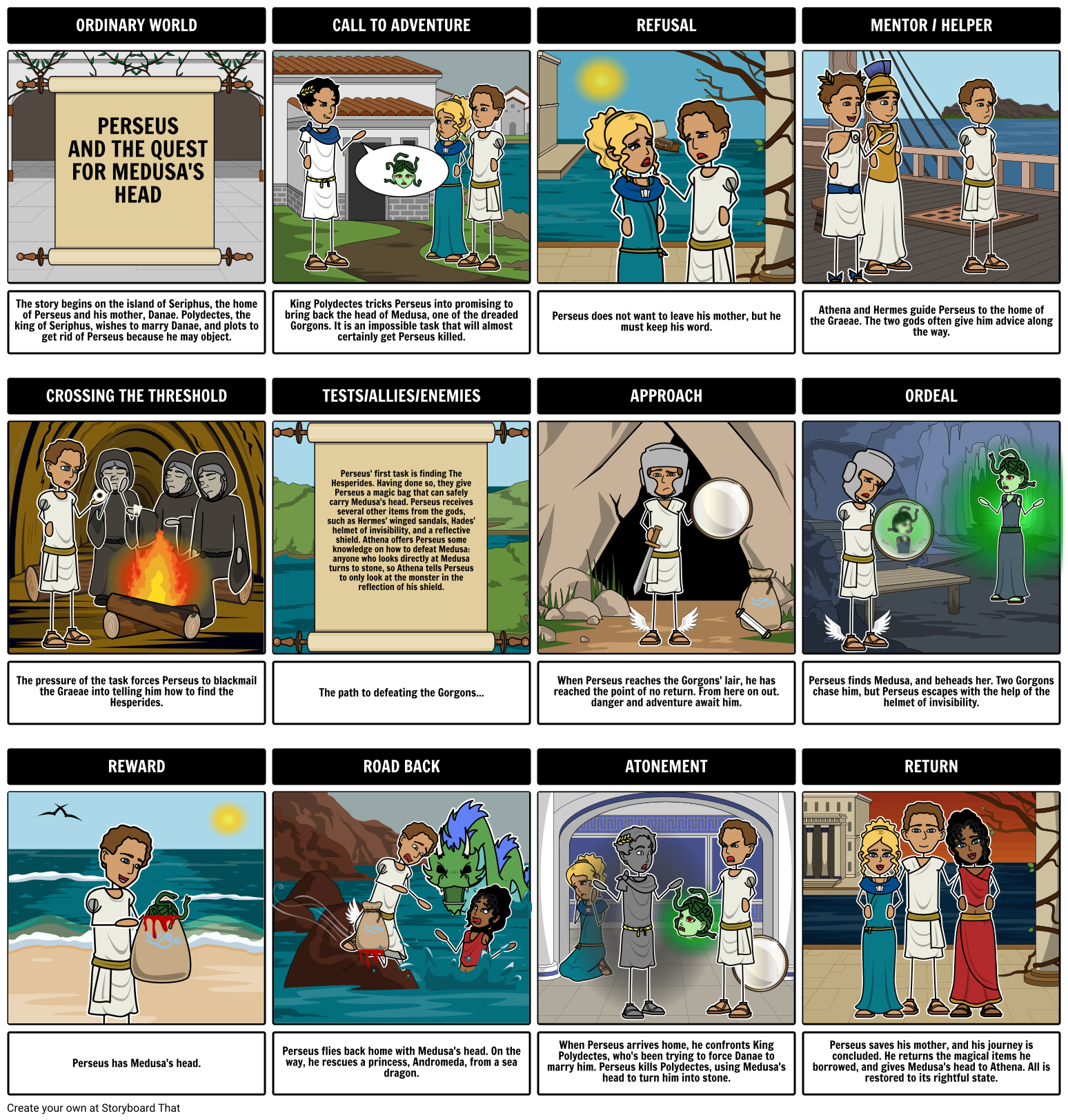
Related to both plot diagram and types of literary conflict, the ”Hero’s Journey” is a recurring pattern of stages many heroes undergo over the course of their stories. Joseph Campbell, an American mythologist, writer, and lecturer, articulated this cycle after researching and reviewing numerous myths and stories from a variety of time periods and regions of the world. He found that they all share fundamental principles. This spawned the Hero’s Journey, also known as the Monomyth. The most basic version has 12 steps, while more detailed versions can have up to 17.
Using the steps of the Hero's Journey, students will illustrate the journey of a Greek hero. The example above uses the story of Perseus, but students can even create Hero's Journey storyboards for Hercules, Theseus, Odysseus, Achilles, Jason, or anyone else.
The Legend of Perseus : An Example of the Monomyth Structure
(These instructions are completely customizable. After clicking "Copy Activity", update the instructions on the Edit Tab of the assignment.)
Student Instructions
Use the story of one of the great ancient heroes and map it to the narrative structure of the Hero's Journey. Choose from Hercules, Perseus, Theseus, Odysseus, Achilles, Jason, or other approved hero.
- Click "Start Assignment".
- Depict and describe how the hero's story fits (or does not fit ) into each of the stages of the Hero's Journey.
- Finalize images, edit, and proofread your work.
- Click "Save & Exit" when done.

Lesson Plan Reference
Grade Level 6-8
Difficulty Level 3 (Developing to Mastery)
Type of Assignment Individual, Partner, or Group
Type of Activity: The Hero's Journey
- [ELA-Literacy/RL/8/2] Determine a theme or central idea of a text and analyze its development over the course of the text, including its relationship to the characters, setting, and plot; provide an objective summary of the text
- [ELA-Literacy/RL/8/5] Compare and contrast the structure of two or more texts and analyze how the differing structure of each text contributes to its meaning and style
- [ELA-Literacy/RL/8/10] By the end of the year, read and comprehend literature, including stories, dramas, and poems, at the high end of grades 6–8 text complexity band independently and proficiently
(You can also create your own on Quick Rubric .)
Greek Mythology
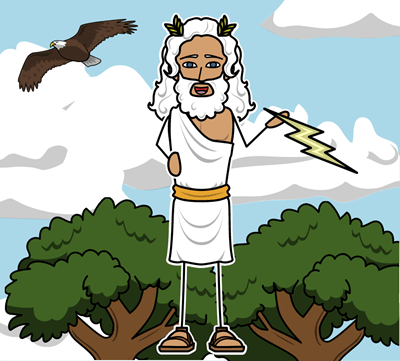
Try 1 Month For
30 Day Money Back Guarantee New Customers Only Full Price After Introductory Offer
Learn more about our Department, School, and District packages

- Thousands of images
- Custom layouts, scenes, characters
- And so much more!!
Create a Storyboard
Hercules in Greek Mythology
This essay about the mythological figure Hercules, also known as Heracles in Greek mythology. It explores his life, adventures, and symbolic significance in ancient Greek culture. Hercules’ story reflects themes of heroism, endurance, divine intervention, and redemption. Through his legendary Twelve Labors and other feats, Hercules exemplifies the quintessential hero, overcoming challenges with strength, cunning, and virtue. His journey, from mortal struggles to divine apotheosis, offers insights into ancient Greek values and beliefs, shaping both classical mythology and modern understandings of heroism and virtue.
How it works
Hercules, or Heracles in Greek mythology, stands as one of the most renowned figures in ancient lore, embodying the archetype of the hero. His adventures, trials, and overarching journey not only provide entertainment but also offer deep insights into the values and concerns of ancient Greek culture. This essay explores the life and deeds of Hercules, analyzing how his mythological path reflects broader themes such as heroism, redemption, and the interaction between the divine and the mortal.
Born to Zeus and Alcmene, Hercules was subject to Hera’s wrath throughout his life due to Zeus’s infidelity.
Hera’s vendetta against Hercules began with his name; “Hera’s glory” is a testament to the complexities of his existence, marked by the goddess’s relentless attempts to destroy him. This divine conflict set the stage for Hercules’ life, a narrative defined by struggle and perseverance against overwhelming odds.
Hercules is perhaps best known for the Twelve Labors, a series of tasks imposed on him as penance for killing his wife Megara and their children in a fit of madness, instigated by Hera. These labors were designed to be impossible tasks, yet Hercules, with his superhuman strength and the aid of divine artifacts, successfully completed them, securing his place as the quintessential hero. Each labor—from slaying the invulnerable Nemean Lion and capturing the Golden Hind of Artemis to obtaining the girdle of Hippolyta, the Queen of the Amazons—highlights a facet of his heroism, as well as his cunning, another esteemed trait in Greek heroic narratives.
Beyond physical strength, Hercules’ labors underscore a thematic exploration of struggle and virtue. They symbolize the human condition, encapsulating the idea that real strength lies in the ability to endure suffering and overcome challenges, a reflection of the Greek philosophical appreciation for endurance and effort. Furthermore, the labors reflect the ancient Greek world’s view of the divine’s interaction with humanity, where gods and goddesses directly influenced, and often complicated, the lives of mortals.
After completing the labors, Hercules continued to undertake significant quests and participated in famous battles and adventures, such as aiding the gods in the battle against the Giants in the Gigantomachy and searching for the Golden Apples of the Hesperides. His involvement in these epic stories not only cements his status as a hero but also as a protector of mankind and the Olympian order, often acting as a bridge between the gods and humanity.
Hercules’ death, which also involved a tragic twist of fate through the deception involving the poisoned shirt of Nessus, ultimately led to his apotheosis. Ascending to Olympus upon his mortal death, Hercules was granted immortality, a rare honor for a hero, which symbolizes the ultimate redemption and glorification of his trials on earth. His deification can be interpreted as a narrative closure that reflects the ancient belief in the possibility of overcoming mortal imperfections and achieving a divine state through heroic deeds.
In conclusion, Hercules in Greek mythology serves as a profound symbol of the hero’s journey, characterized by trials, suffering, and eventual transcendence. His story offers a rich tapestry through which to explore themes of heroism, the impact of divine influence, and the moral and philosophical dilemmas of the ancient Greeks. Hercules remains a timeless figure, representing the eternal struggle against adversity and the quest for redemption. His myths not only shaped ancient Greek culture but continue to influence modern interpretations of heroism and virtue.
Cite this page
Hercules In Greek Mythology. (2024, Apr 29). Retrieved from https://papersowl.com/examples/hercules-in-greek-mythology/
"Hercules In Greek Mythology." PapersOwl.com , 29 Apr 2024, https://papersowl.com/examples/hercules-in-greek-mythology/
PapersOwl.com. (2024). Hercules In Greek Mythology . [Online]. Available at: https://papersowl.com/examples/hercules-in-greek-mythology/ [Accessed: 1 May. 2024]
"Hercules In Greek Mythology." PapersOwl.com, Apr 29, 2024. Accessed May 1, 2024. https://papersowl.com/examples/hercules-in-greek-mythology/
"Hercules In Greek Mythology," PapersOwl.com , 29-Apr-2024. [Online]. Available: https://papersowl.com/examples/hercules-in-greek-mythology/. [Accessed: 1-May-2024]
PapersOwl.com. (2024). Hercules In Greek Mythology . [Online]. Available at: https://papersowl.com/examples/hercules-in-greek-mythology/ [Accessed: 1-May-2024]
Don't let plagiarism ruin your grade
Hire a writer to get a unique paper crafted to your needs.

Our writers will help you fix any mistakes and get an A+!
Please check your inbox.
You can order an original essay written according to your instructions.
Trusted by over 1 million students worldwide
1. Tell Us Your Requirements
2. Pick your perfect writer
3. Get Your Paper and Pay
Hi! I'm Amy, your personal assistant!
Don't know where to start? Give me your paper requirements and I connect you to an academic expert.
short deadlines
100% Plagiarism-Free
Certified writers
Breaking Down the Character Archetypes of the Hero’s Journey
You’ve read about George Lucas’s use of Joseph Campbell’s Monomyth found in his 1949 book, A Hero with a Thousand Faces , which is a common narrative pattern found in many stories from many different cultures worldwide. This narrative journey typically involves several character archetypes that affect the hero’s journey from beginning to end.
After the successful debut of Star Wars and Lucas’s discussions on using Campbell’s work as inspiration for his space opera, many producers, development executives, filmmakers, and screenwriters have explored the Monomyth with deeper and simplified approaches.
Christopher Vogler's Interpretation of the Hero's Journey
When Christopher Vogler, a development executive and screenwriter at Disney, was inspired by Joseph Campbell's concept of the story monomyth, he crafted a seven-page memo for Disney's development team and incoming screenwriters.
This memo, A Practical Guide to Joseph Cambell’s The Hero with a Thousand Faces , laid the groundwork for what would later become Vogler's 1992 book, The Writer's Journey: Mythic Structure for Storytellers and Screenwriters . In this book, Vogler expanded upon Campbell’s ideas.
He adapted Campbell's mythical story structure into twelve distinct stages (from Campbell’s initial seventeen). Our concise interpretations of these stages include:
- The Ordinary World : We see the hero's normal life at the start of the story before the adventure begins.
- Call to Adventure : The hero faces an event, conflict, problem, or challenge that makes them begin their adventure.
- Refusal of the Call : The hero initially refuses the adventure because of hesitation, fear, insecurity, or any other issues.
- Meeting the Mentor : The hero encounters a mentor who can give them advice, wisdom, information, or items that ready them for the journey ahead.
- Crossing the Threshold : The hero leaves their ordinary world for the first time and crosses the threshold into adventure.
- Tests, Allies, and Enemies : The hero learns the rules of the new world and endures tests, meets friends, and comes face-to-face with enemies.
- The Approach : The initial plan to take on the central conflict begins, but setbacks cause the hero to try a new approach or adopt new ideas.
- The Ordeal : Things go wrong, and added conflict is introduced . The hero experiences more difficult hurdles and obstacles, some of which may lead to a life crisis.
- The Reward : After surviving The Ordeal, the hero seizes the sword — a reward that they've earned that allows them to take on the biggest conflict. It may be a physical item or piece of knowledge or wisdom that will help them persevere.
- The Road Back : The hero sees the light at the end of the tunnel, but they are about to face even more tests and challenges.
- The Resurrection : The climax. The hero faces a final test, using everything they have learned to take on the conflict once and for all.
- The Return : The hero brings their knowledge or the " elixir " back to the ordinary world.
Within these stages are character archetypes that help to shape the hero’s journey, and their eventual character arc throughout the story.
Read More: Exploring the Twelve Stages of the Hero’s Journey
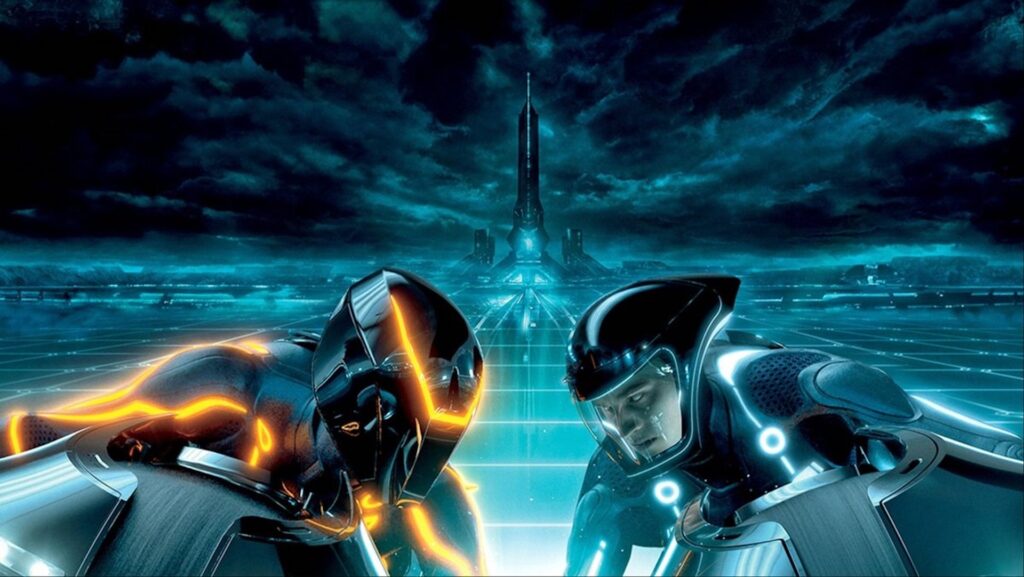
'Tron: Legacy' (2010)
What Are Character Archetypes?
A character archetype is a common recurring representation of a character that embodies a set of universal and recognizable traits or characteristics. These archetypes are seen throughout literature, film, and other storytelling mediums—and they resonate with audiences because they are based on common human experiences or cultural norms.
Archetypes work well because they are instantly recognizable to readers and audiences. For writers, character archetypes can be adapted and molded with ease during character development.
Character archetypes are not specific characters in a story but rather broad categories or templates that individual characters can be based on or inspired by. They represent typical roles characters play in the narrative, and their actions and motivations are often predictable based on the archetype they represent.
However, writers can also choose to subvert those expectations to create a more dynamic character , as well as introduce much-needed twists and turns within the story.
Read More: 10 Character Archetypes in Comedies
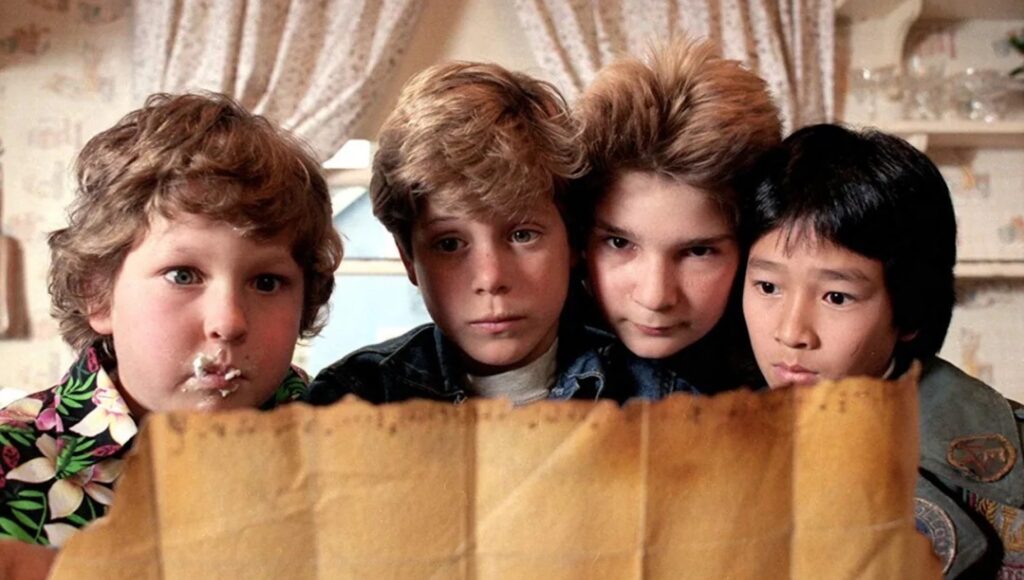
'The Goonies' (1950)
The benefits of using character archetypes include:
- Universality : Archetypes are universally understood and have similar meanings across cultures and historical contexts. This can especially help in the cinematic realm as movies are released in multiple countries and languages.
- Symbolism : These character traits can symbolize a particular aspect of human experience or life. Once again, symbolism is identifiable across many cultures.
- Predictability : Because they are based on common patterns, their behaviors and roles in stories can often be anticipated . Because of that anticipation, writers can choose between subverting those expectations or using the predictability of the archetypes to service the story and protagonist with ease.
- Variability : While archetypes are typical patterns, they allow for variations and depth, meaning a single archetype can manifest in different ways across various stories, allowing writers can adapt these traits to any character.
Character archetypes can be used as tools to tell a compelling and universal story.
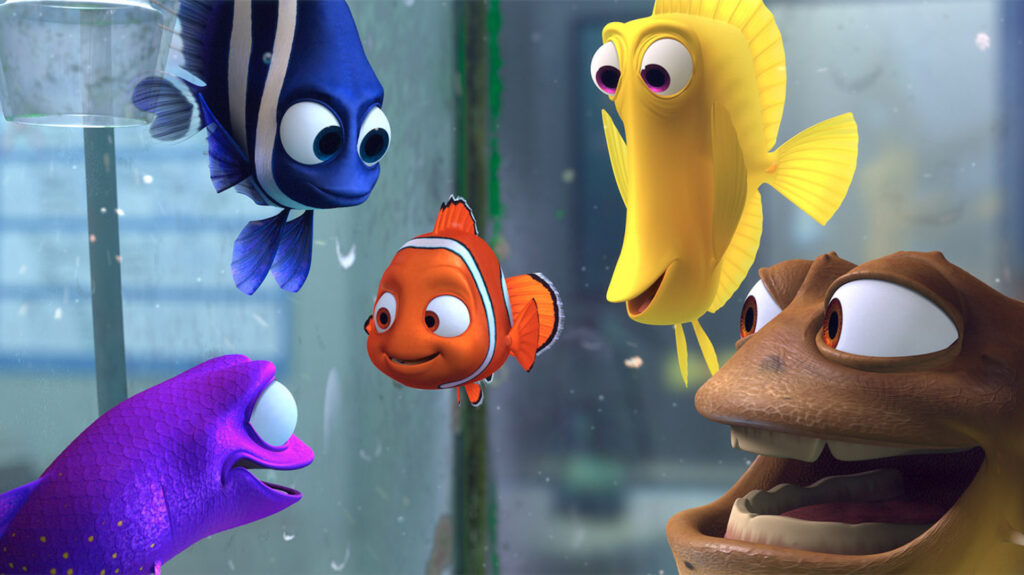
'Finding Nemo' (2003)
What Are the Character Archetypes in the Hero's Journey?
Many archetypes in the hero's journey—the threshold guardian, the herald, the shapeshifter, the trickster, the ally, and the tempter/temptress—are more defined in later interpretations and expansions of Campbell's work. People like Vogler applied his theories to modern storytelling so writers, readers, and audiences could more easily understand the dynamics of Campbell’s monomyth.
Here, we’ll break down the main character archetypes in the hero's journey utilized in Campbell’s Monomyth and Vogler’s expanded breakdowns and interpretations.
The hero is the central figure of the story (protagonist) who undergoes a journey, facing challenges and transformations. The hero often starts as an ordinary person who is then called to adventure. They are present throughout the entire journey , from the ordinary world to the return with newfound knowledge or power.
Luke Skywalker (Star Wars), Indiana Jones ( Raiders of the Lost Arc ), Katniss Everdeen ( The Hunger Games ), Barbie ( Barbie ), and Harry Potter (the Harry Potter series) are perfect examples of the hero character archetypes. You can include any protagonist within a story that goes on a physical or emotional journey.
As mentioned above, the hero in the hero’s journey usually begins their adventure within their ordinary world. This offers readers and audiences the chance to relate to the protagonist, empathize with their plight, and see the beginning of their character arc.
Read More: Why the 'Barbie' Movie is the Perfect Example of the Hero’s Journey
The shadow is the main antagonist of the story. The shadow reflects the darker aspects of the hero, sometimes represented as the mirror image (opposite) of the hero and their beliefs. Overall, they are the antagonist or villains present throughout the whole story in varied ways.
Read More: 15 Types of Villains Screenwriters Need to Know
The shadow can also be represented in metaphorical terms. If a story’s hero journey is the protagonist dealing with alcoholism or addiction, those vices can serve as the shadow/antagonist/villain.
The quintessential shadows in cinema include characters like Darth Vader ( Star Wars ), Voldemort (the Harry Potter series), and Sauron ( The Lord of the Rings series). But you can also find a less villainous shadow that takes on a lighter antagonistic role without purely evil intentions.
A perfect example of that would be Principal Rooney in Ferris Bueller’s Day Off . He doesn’t have evil intentions like a villain does. However, he is the shadow or mirror image of Ferris Bueller. Ferris believes in freedom an expression . Rooney believes in order and control of others.
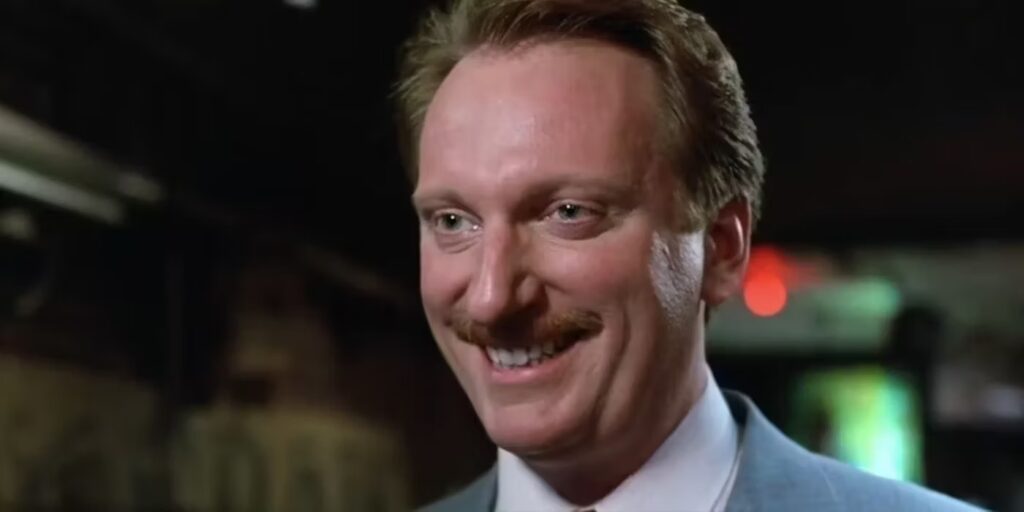
'Ferris Bueller's Day Off' (1986)
This character serves as a guide or teacher to the hero, providing them with advice, training, or magical assistance. The mentor is often a wise or experienced figure, although there have been literary and cinematic variances.
Look no further than the likes of Obi-Wan Kenobi ( Star Wars ), Yoda ( The Empire Strikes Back ), Mr. Miyagi ( The Karate Kid ), and Gandalf ( The Lord of the Rings series ) as core examples of the mentor.
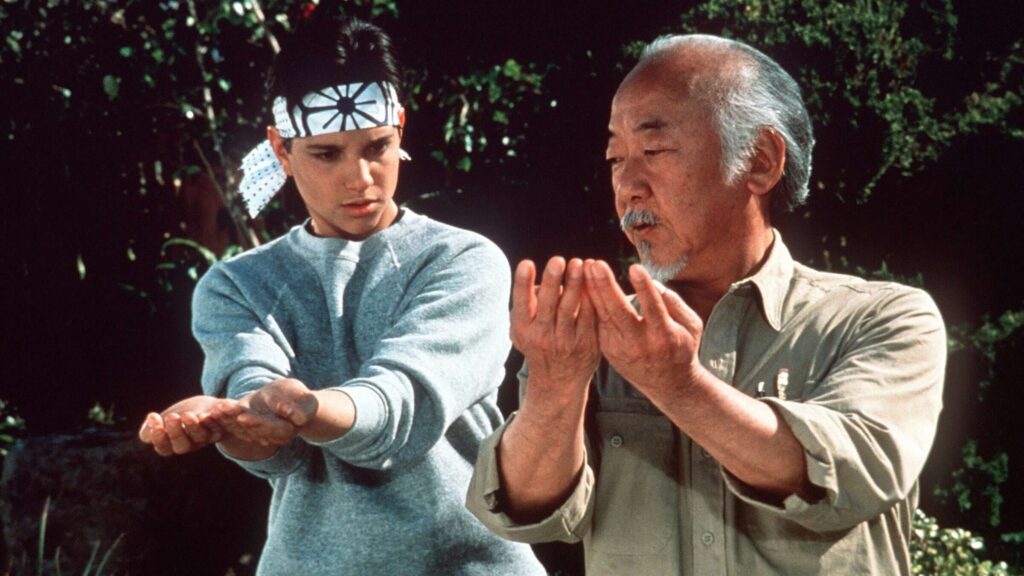
'The Karate Kid' (1984)
Allies are friends or companions who support and accompany the hero through their journey. They often complement the hero's skills and help them face challenges.
In Star Wars , the allies of Luke Skywalker include Han Solo, Chewbacca, and the droids. In The Lord of the Rings series , the fellowship companions of Frodo encompass this character archetype. You can also look to any sidekick-type character as the perfect example of an ally:
- Goose in Top Gun
- Patrick in Spongebob Squarepants
- Ron in Harry Potter
- Billy in Big
- Julie in Lady Bird
- Rod in Get Out
- Ned in the Spider-Man movies
- Sam in The Lord of the Rings
- Short Round in Indiana Jones and the Temple of Doom
Allies can also be characters who aren’t as close to the hero but offer some type of help along the way.

'Lady Bird' (2017)
The Threshold Guardian
These characters serve as obstacles the hero must overcome or circumvent on their journey. They are not always enemies but are present within the story to test the hero and give them the belief and ability to continue on their adventure.
Little John in the Robin Hood stories is initially the threshold guardian of the Sherwood Forest.
He eventually becomes an ally to Robin. But he’s initially a threshold guardian.
You can turn to Monthy Python and the Holy Grail as well. The Black Knight isn’t necessarily King Arthur’s foe. However, he’s there to defend the bridge at all costs.
The Herald
The herald is the character that initiates the call to adventure, pushing the hero to action, or providing the news or event that triggers their journey.
In Star Wars , R2-D2 is the herald of Luke’s journey because he delivers the message from Princess Leia to him . If Luke doesn’t see that message, he doesn’t show it to Obi-Wan Kenobi. And if Obi-Wan doesn’t see that message, he doesn’t convince Luke to come with him to join the Rebellion.
In Barbie , Weird Barbie is the one who tells Barbie the truth about what she is going through and what she must do to seek out the answers she needs.
The herald can be a major character, a supporting character, or even a minor character. In The Lord of the Rings , Gandalf is both mentor and herald, as he is the one who appears to Frodo, telling him he must bring the ring to Mordor.
The Shapeshifter
This archetype's loyalty and role are often unclear, and they can serve as an ally or an enemy to the hero. Sometimes both. Their unpredictable nature adds complexity to the story, usually resulting in twists and turns within the plot.
Snape in the Harry Potter series is one of the greatest shapeshifters in literature and film. His motives are unknown, mistaken, and hidden. He acts as both a shadow to Harry and later an ally.
Jack Sparrow in the Pirates of the Caribbean series is another great example, embodying the role of an unpredictable ally whose loyalty is often questionable. Yes, he can be looked upon as an antihero protagonist of the movie. However, the clear hero of the story is Will.
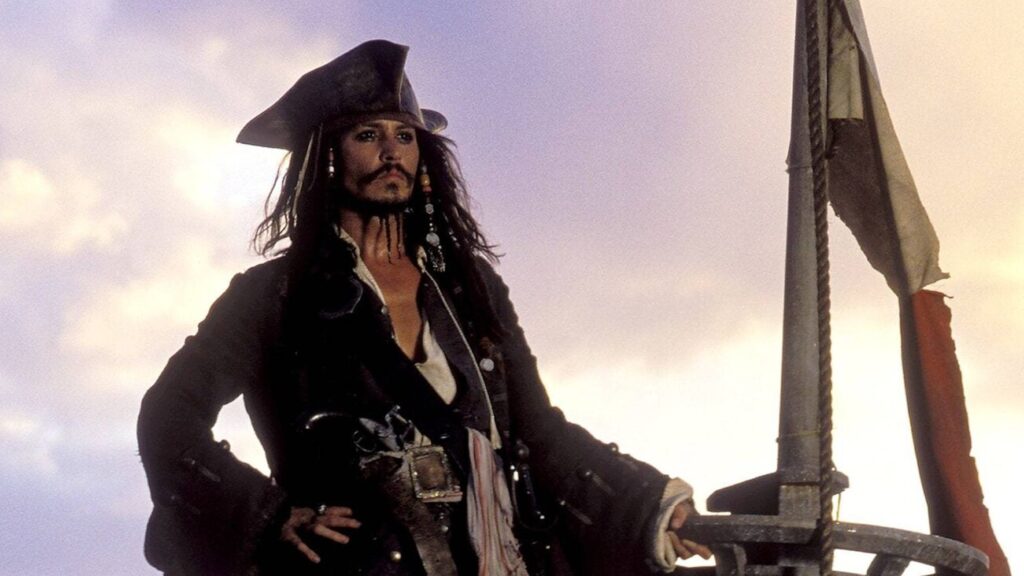
'Pirates of the Caribbean: The Curse of the Black Pearl' (2003)
The Trickster
The trickster usually adds levity to the story through comic relief. They can be allies or enemies, but typically they cause trouble for both.
Jack Sparrow falls under this character archetype as well. But a better example may be Loki in the Marvel Cinematic Universe movies. He embodies the definition of a trickster. He brings more comic relief to the movies after his initial first appearance in Thor .
Perhaps the better example would be Genie in Disney's Aladdin . He uses his powers for humorous and unexpected effects, often bending the rules and adding a lighthearted element to the story.
Tempter/Temptress
This archetype can be of any gender and represents temptation or distraction that diverts the hero from their path.
Catwoman in the Batman movies often plays the role of a temptress to Batman, combining allure with a morally ambiguous character.
Many of the Bond Girls in the James Bond films serve as temptresses, combining allure and mystery and often leading Bond into dangerous situations.
The Indiana Jones variation would be Elsa from Indiana Jones and the Last Crusade .
One of the best examples of the Tempter playing a more pivotal role in the story is Avery Tolar in The Firm . He’s a senior partner at the law firm Bendini, Lambert & Locke. His role is crucial in seducing the protagonist, Mitch McDeere, into the luxurious and corrupt world of the law firm.
He has a charismatic and persuasive personality. He mentors Mitch and exposes him to the high-stakes, high-reward lifestyle that the firm offers, including wealth, prestige, and power. Tolar's character is complex. He is a nuanced character who embodies the charm and allure that the firm uses to entice and trap its young associates.
His influence on Mitch is significant, as he represents the allure of success and the moral compromises that often accompany it. Tolar's character effectively demonstrates how the tempter archetype can be used to explore themes of corruption, temptation, and ethical dilemmas in a narrative.
The character archetypes found within the h ero’s journey offer writers the ability to take universal character templates and mold them to fit into stories that embrace the monomyth structure or use it as a starting point to tell a compelling and engaging story.
Use them in whatever way you’d like. They can encompass the more traditional definition within your story, or you can use these archetypes to set up expectations and later subvert those expectations to create a more enthralling and surprising plot.
Read More: Is Joseph Campbell's "The Hero's Journey" Dead in Screenwriting Today?
CHECK OUT OUR PREPARATION NOTES SO YOU START YOUR STORY OFF ON THE RIGHT TRACK!

Ken Miyamoto has worked in the film industry for nearly two decades, most notably as a studio liaison for Sony Studios and then as a script reader and story analyst for Sony Pictures.
He has many studio meetings under his belt as a produced screenwriter, meeting with the likes of Sony, Dreamworks, Universal, Disney, Warner Brothers, as well as many production and management companies. He has had a previous development deal with Lionsgate, as well as multiple writing assignments, including the produced miniseries Blackout, starring Anne Heche, Sean Patrick Flanery, Billy Zane, James Brolin, Haylie Duff, Brian Bloom, Eric La Salle, and Bruce Boxleitner, the feature thriller Hunter’s Creed, and many Lifetime thrillers. Follow Ken on Twitter @KenMovies and Instagram @KenMovies76
Get Our Screenwriting Newsletter!
Get weekly writing inspiration delivered to your inbox - including industry news, popular articles, and more!
Facebook Comments
Free download.

Screenwriting Resources:

$ 15.00 $ 12.00 Add to cart
Popular Posts

Recent Posts
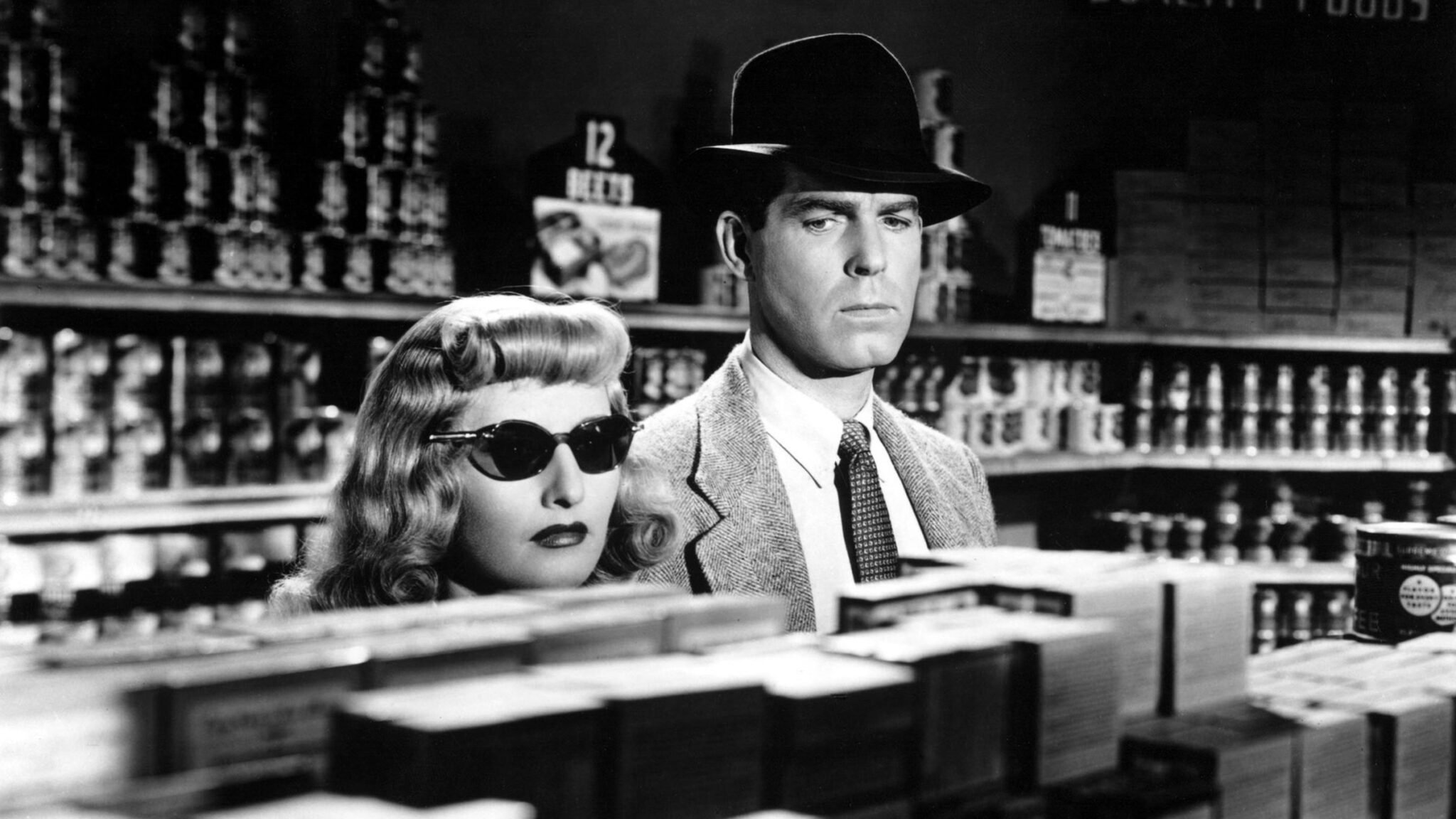
Next Related Post
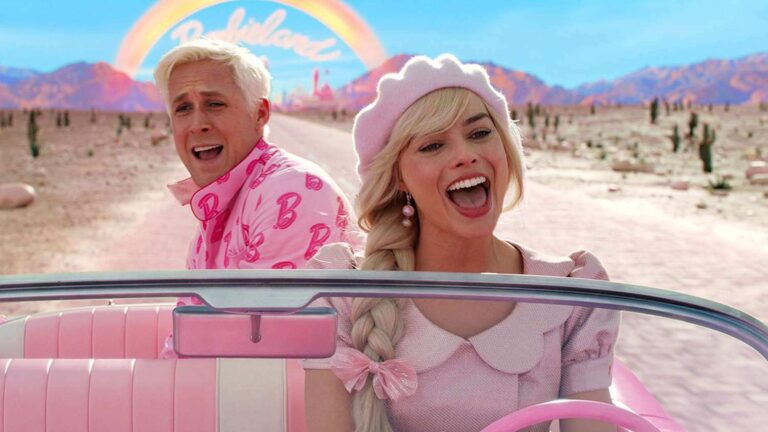
Get Our Newsletter!
Developing your own script.
We'll send you a list of our free eCourses when you subscribe to our newsletter. No strings attached.
You Might Also Like
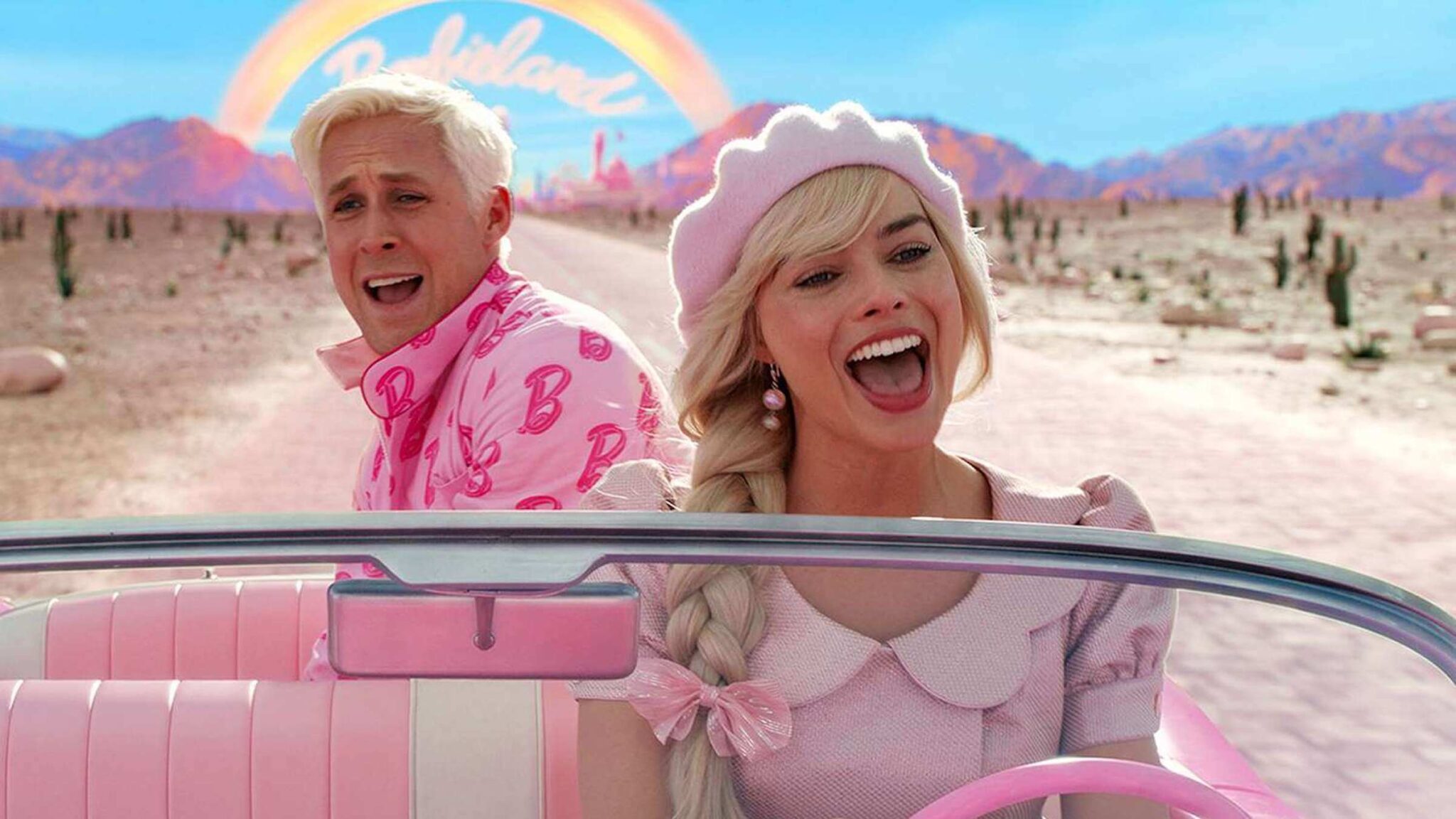
- Hidden Name
- Comments This field is for validation purposes and should be left unchanged.
Connect With Us
Writing competitions, success stories.
© 2024 ScreenCraft | An Industry Arts Company
Wait! Subscribe to get our free Newsletter
Join our community of over 100,000 screenwriters and get weekly inspiration delivered to your inbox.
Screenwriting Newsletter
Join our community of over 100,000 screenwriters and get weekly inspiration delivered to your inbox:
✓ Popular blog posts and industry news ✓ New ScreenCraft online events ✓ Screenplay competition announcements!
" * " indicates required fields

COMMENTS
Read on to discover the Hercules hero's journey. Hercules - also known as Heracles - and his twelve labors, are one of the staples of Greek mythology. The story has even been transformed into a Disney movie and plenty of big-budget action-adventure fantasy films over the years. The hero's journey structure can be clearly identified in ...
Hercules was a hero of Greek and Roman mythology. He succeeds at completing 12 labors of incredible difficulty, securing his eternal immortality with the gods.
Imagine Hercules, our legendary hero, trying to navigate his regular, chaotic day-to-day life, when suddenly he's faced with a tough decision. He's tasked with completing the twelve labors - a monumental challenge that scares him to his core. This stage of his journey, known as 'The Call and Refusal', really shows us his human side ...
The Hero's Journey is a framework that scholar Joseph Campbell came up with that many myths and stories follow. Many storytellers and story-readers find it a useful way to look at tale. (That's actually putting it lightly. Some people are straight-up obsessed.) Chris Vogler adapted Campbell's 17 stages of a hero's journey, which many ...
Heracles - or Hercules as he has been more popularly known ever since the Roman times - was the greatest of all Greek heroes, "one who surpassed all men of whom memory from the beginning of time has brought down an account."A half-god of superhuman strength and violent passions, Heracles was the epitome of bravery and masculinity in the ancient world and the most notable champion of ...
Joseph Campbell's Hero's Journey, while based on his study of mythology around the world, can be applied to more than just myth. In fact, it's applied to film frequently. One of the clearest examples of Campbell's Hero's Journey is none other than George Lucas's film Star Wars: A New Hope (1977). To this film we now turn.
In this exciting video, we delve into the legendary adventures of Hercules, the mighty son of Zeus, as he undertakes the twelve epic tasks known as the "Labo...
Hercules' life can be divided into distinct phases, with each phase marked by extraordinary challenges and accomplishments. The most renowned episode of Hercules' journey is his completion of the Twelve Labors. Driven to madness by Hera, Zeus' wife and Hercules' stepmother, he unwittingly killed his wife and children.
The Labors of Hercules. The goddess Hera, determined to make trouble for Hercules, made him lose his mind. ... By the end of these Labors, Hercules was, without a doubt, Greece's greatest hero. His struggles made Hercules the perfect embodiment of an idea the Greeks called pathos, the experience of virtuous struggle and suffering which would ...
Illustration of the hero's journey. In narratology and comparative mythology, the hero's journey, also known as the monomyth, is the common template of stories that involve a hero who goes on an adventure, is victorious in a decisive crisis, and comes home changed or transformed.. Earlier figures had proposed similar concepts, including psychoanalyst Otto Rank and amateur anthropologist Lord ...
This is a breakdown of the steps of the archetype of the hero's journey using clips from Disney's Hercules to explain. My students were struggling with the c...
Hercules battles a river guardian named Nessus. Signifies Hercules moving into the field of adventure. Hercules is still in Thebes when Megara approaches him calling for help. He easily frees the two boys that were trapped beneath a boulder, but faces a larger problem: the Hydra. Once the Hydra is defeated, the townspeople view Hercules as a hero.
Hercules sets out on the quest to find his identity and fulfills the monomyth's departure sequence. The Initiation. In this phase of the hero's journey change occurs to the hero; in other words they become the hero — physically and mentally. The individual faces challenges and trials to build themselves anew and create the hero image.
In Part 2 of my study on Hercules, I'm discussing how Meg and Hercules fit within Joseph Campbell's narrative structure of the Hero's Journey. Does Meg quali...
The Reward and the Road Back. From Christopher Vogler's "The Writer's Journey: Mythic Structure". Once our hero has cheated death during the ordeal and has seized the sword, the much sought-after prize is hers. The prize of the hero's journey can be an actual object, like a holy grail, or it can mean the knowledge and experience that lead to ...
Furthermore, the theme of Hercules, which centers around the idea of a hero's journey, has transcended time and culture. The story of a hero facing trials and tribulations, finding strength within themselves, and ultimately triumphing over adversity is a universal tale that continues to resonate with people today.
12 Stages of a Heroic Journey By: Tiajahanae Armstrong 7. Approach to the Inmost Cave The hero is at a turning point must accept all the risks including failure. Hercules meets Hades. Hades wants Hercules to take the day off from helping and saving people in exchange for Meg's
The Hero's Journey: Crossing the Threshold. The hero, armed with the mentor's gifts, agrees to face the journey. This is the turning point between Act One and Act Two, the crossing from the ordinary world into the special world. The hero is wholeheartedly committed and there is no turning back. According to Christopher Vogler's The Writer's ...
Hercules: The Legendary Journeys is an American fantasy television series filmed in New Zealand, based on the tales of the classical Greco-Roman culture hero Heracles (Hercules was his Roman analogue). Starring Kevin Sorbo as Hercules and Michael Hurst as Iolaus, it was produced from January 16, 1995, to November 22, 1999.It ran for six seasons, producing action figures and other memorabilia ...
Origin. The monomyth, or Hero's Journey, was first recognized as a pattern in mythology by Joseph Campbell, who noticed that heroes in mythology typically go through the same 17 stages in their journey toward hero-dom. The Hero's Journey follows a path which is represented by a circle in which the hero travels into the unknown and is faced ...
After clicking "Copy Activity", update the instructions on the Edit Tab of the assignment.) Student Instructions. Use the story of one of the great ancient heroes and map it to the narrative structure of the Hero's Journey. Choose from Hercules, Perseus, Theseus, Odysseus, Achilles, Jason, or other approved hero. Click "Start Assignment".
The Hero's Journey is a narrative pattern identified by Joseph Campbell, most notably outlined in his book The Hero with a Thousand Faces . This pattern of adventure and transformation is a universal one that runs through all kinds of mythic traditions across the world. Christopher Vogler has si
#MythicalChronicles #AncientLegends #HistoricalNarratives #StoriesOfThePast #ExploringMythology #AncientCivilizations #LegendsFromHistory #MythologyLovers #T...
In conclusion, Hercules in Greek mythology serves as a profound symbol of the hero's journey, characterized by trials, suffering, and eventual transcendence. His story offers a rich tapestry through which to explore themes of heroism, the impact of divine influence, and the moral and philosophical dilemmas of the ancient Greeks.
Christopher Vogler's Interpretation of the Hero's Journey. When Christopher Vogler, a development executive and screenwriter at Disney, was inspired by Joseph Campbell's concept of the story monomyth, he crafted a seven-page memo for Disney's development team and incoming screenwriters. This memo, A Practical Guide to Joseph Cambell's The Hero with a Thousand Faces, laid the groundwork for ...